Amsterdam
Amsterdam (/ˈæmstərdæm/, UK also /ˌæmstərˈdæm/;[10][11] Dutch: [ɑmstərˈdɑm] (![]()
Amsterdam | |
|---|---|
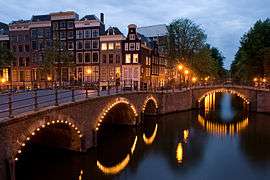   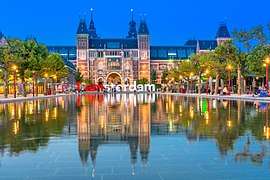 From top down, left to right: Keizersgracht, canal in the Centrum borough, the Royal Concertgebouw and Rijksmuseum | |
| Nicknames: Mokum, the Venice of the North | |
| Motto(s): Heldhaftig, Vastberaden, Barmhartig (Valiant, Steadfast, Compassionate) | |
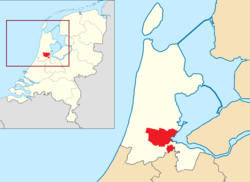 Location of Amsterdam in the province of North Holland | |
 Amsterdam Location of Amsterdam in the Netherlands  Amsterdam Amsterdam (Europe) | |
| Coordinates: 52°22′N 4°54′E | |
| Country | |
| Province | |
| City Hall | Stopera |
| Boroughs | |
| Government | |
| • Body | Municipal council |
| • Mayor | Femke Halsema (GL) |
| Area | |
| • Municipality | 219.32 km2 (84.68 sq mi) |
| • Land | 165.76 km2 (64.00 sq mi) |
| • Water | 53.56 km2 (20.68 sq mi) |
| • Randstad | 3,043 km2 (1,175 sq mi) |
| Elevation | −2 m (−7 ft) |
| Population | |
| • Municipality | 872,680 |
| • Density | 5,206/km2 (13,480/sq mi) |
| • Urban | 1,380,872 |
| • Metro region | 2,431,000 |
| • Randstad | 8,116,000 |
| Demonym(s) | Amsterdammer |
| Time zone | UTC+1 (CET) |
| • Summer (DST) | UTC+2 (CEST) |
| Postcode | 1000–1183 |
| Area code | 020 |
| GeoTLD | .amsterdam |
| Website | www |
Amsterdam's name derives from Amstelredamme,[15] indicative of the city's origin around a dam in the river Amstel. Originating as a small fishing village in the late 12th century; Amsterdam became one of the most important ports in the world during the Dutch Golden Age of the 17th century; and became the leading centre for finance and trade.[16] In the 19th and 20th centuries, the city expanded, and many new neighbourhoods and suburbs were planned and built. The 17th-century canals of Amsterdam and the 19–20th century Defence Line of Amsterdam are on the UNESCO World Heritage List. Sloten, annexed in 1921 by the municipality of Amsterdam; is the oldest part of the city, dating to the 9th century.
Amsterdam's main attractions include its historic canals, the Rijksmuseum, the Van Gogh Museum, the Stedelijk Museum, Hermitage Amsterdam, the Concertgebouw, the Anne Frank House, the Scheepvaartmuseum, the Amsterdam Museum, the Heineken Experience, the Royal Palace of Amsterdam, Natura Artis Magistra, Hortus Botanicus Amsterdam, NEMO, the red-light district and many cannabis coffee shops. Drawing more than 5 million international visitors in 2014.[17] The city is also well known for its nightlife and festival activity; with several of its nightclubs (Melkweg, Paradiso) among the world's most famous. Primarily known for its artistic heritage, elaborate canal system and narrow houses with gabled façades; well-preserved legacies of the city’s 17th-century Golden Age. These characteristics are arguably responsible for attracting millions of Amsterdam's visitors annually. Cycling is key to the city’s character, and there are numerous bike paths.
The Amsterdam Stock Exchange is considered the oldest “modern" securities market stock exchange in the world. As the commercial capital of the Netherlands and one of the top financial centres in Europe, Amsterdam is considered an alpha-world city by the Globalization and World Cities (GaWC) study group. The city is also the cultural capital of the Netherlands.[18] Many large Dutch institutions have their headquarters in the city, including: the Philips conglomerate, AkzoNobel, Booking.com, TomTom, and ING.[19] Moreover, many of the world's largest companies are based in Amsterdam or have established their European headquarters in the city, such as leading technology companies Uber, Netflix and Tesla.[20] In 2012, Amsterdam was ranked the second best city to live in by the Economist Intelligence Unit (EIU)[21] and 12th globally on quality of living for environment and infrastructure by Mercer.[22] The city was ranked 4th place globally as top tech hub in the Savills Tech Cities 2019 report (2nd in Europe),[23] and 3rd in innovation by Australian innovation agency 2thinknow in their Innovation Cities Index 2009.[24] The Port of Amsterdam is the fifth largest in Europe.[25] The KLM hub and Amsterdam's main airport: Schiphol, is the Netherlands' busiest airport as well as the fourth busiest in Europe. The Dutch capital is considered one of the most multicultural cities in the world, with at least 177 nationalities represented.[26]
A few of Amsterdam's notable residents throughout history include: painters Rembrandt and Van Gogh, the diarist Anne Frank, and philosopher Baruch Spinoza.
Etymology
After the floods of 1170 and 1173, locals near the river Amstel built a bridge over the river and a dam across it, giving its name to the village: "Aemstelredamme". The earliest recorded use of that name is in a document dated 27 October 1275, which exempted inhabitants of the village from paying bridge tolls to Count Floris V.[27][28] This allowed the inhabitants of the village of Aemstelredamme to travel freely through the County of Holland, paying no tolls at bridges, locks and dams. The certificate describes the inhabitants as homines manentes apud Amestelledamme (people residing near Amestelledamme).[29] By 1327, the name had developed into Aemsterdam.[27][30]
History
Founding and Middle Ages
.jpg)
Amsterdam is much younger than Dutch cities such as Nijmegen, Rotterdam, and Utrecht. In October 2008, historical geographer Chris de Bont suggested that the land around Amsterdam was being reclaimed as early as the late 10th century. This does not necessarily mean that there was already a settlement then, since reclamation of land may not have been for farming—it may have been for peat, for use as fuel.[31]
Amsterdam was granted city rights in either 1300 or 1306.[32] From the 14th century on, Amsterdam flourished, largely from trade with the Hanseatic League. In 1345, an alleged Eucharistic miracle in the Kalverstraat rendered the city an important place of pilgrimage until the adoption of the Protestant faith. The Miracle devotion went underground but was kept alive. In the 19th century, especially after the jubilee of 1845, the devotion was revitalized and became an important national point of reference for Dutch Catholics. The Stille Omgang—a silent walk or procession in civil attire—is the expression of the pilgrimage within the Protestant Netherlands since the late 19th century.[33] In the heyday of the Silent Walk, up to 90,000 pilgrims came to Amsterdam. In the 21st century this has reduced to about 5000.
Conflict with Spain

In the 16th century, the Dutch rebelled against Philip II of Spain and his successors. The main reasons for the uprising were the imposition of new taxes, the tenth penny, and the religious persecution of Protestants by the newly introduced Inquisition. The revolt escalated into the Eighty Years' War, which ultimately led to Dutch independence.[34] Strongly pushed by Dutch Revolt leader William the Silent, the Dutch Republic became known for its relative religious tolerance. Jews from the Iberian Peninsula, Huguenots from France, prosperous merchants and printers from Flanders, and economic and religious refugees from the Spanish-controlled parts of the Low Countries found safety in Amsterdam. The influx of Flemish printers and the city's intellectual tolerance made Amsterdam a centre for the European free press.[35]
Centre of the Dutch Golden Age

The 17th century is considered Amsterdam's Golden Age, during which it became the wealthiest city in the western world.[37] Ships sailed from Amsterdam to the Baltic Sea, North America, and Africa, as well as present-day Indonesia, India, Sri Lanka, and Brazil, forming the basis of a worldwide trading network. Amsterdam's merchants had the largest share in both the Dutch East India Company and the Dutch West India Company. These companies acquired overseas possessions that later became Dutch colonies.
Amsterdam was Europe's most important point for the shipment of goods and was the leading Financial centre of the western world.[38] In 1602, the Amsterdam office of the international trading Dutch East India Company became the world's first stock exchange by trading in its own shares. The Bank of Amsterdam started operations in 1609, acting as a full service bank for Dutch merchant bankers and as a reserve bank.
Decline and modernisation
Amsterdam's prosperity declined during the 18th and early 19th centuries. The wars of the Dutch Republic with England and France took their toll on Amsterdam. During the Napoleonic Wars, Amsterdam's significance reached its lowest point, with Holland being absorbed into the French Empire. However, the later establishment of the United Kingdom of the Netherlands in 1815 marked a turning point.

The end of the 19th century is sometimes called Amsterdam's second Golden Age.[40] New museums, a railway station, and the Concertgebouw were built; in this same time, the Industrial Revolution reached the city. The Amsterdam–Rhine Canal was dug to give Amsterdam a direct connection to the Rhine, and the North Sea Canal was dug to give the port a shorter connection to the North Sea. Both projects dramatically improved commerce with the rest of Europe and the world. In 1906, Joseph Conrad gave a brief description of Amsterdam as seen from the seaside, in The Mirror of the Sea.
20th century–present
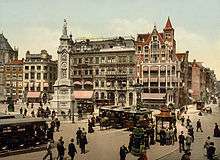
Shortly before the First World War, the city started to expand again, and new suburbs were built. Even though the Netherlands remained neutral in this war, Amsterdam suffered a food shortage, and heating fuel became scarce. The shortages sparked riots in which several people were killed. These riots are known as the Aardappeloproer (Potato rebellion). People started looting stores and warehouses in order to get supplies, mainly food.[41]
On 1 January 1921, after a flood in 1916, the depleted municipalities of Durgerdam, Holysloot, Zunderdorp and Schellingwoude, all lying north of Amsterdam, were, at their own request, annexed to the city.[42][43] Between the wars, the city continued to expand, most notably to the west of the Jordaan district in the Frederik Hendrikbuurt and surrounding neighbourhoods.
Nazi Germany invaded the Netherlands on 10 May 1940 and took control of the country. Some Amsterdam citizens sheltered Jews, thereby exposing themselves and their families to a high risk of being imprisoned or sent to concentration camps. More than 100,000 Dutch Jews were deported to Nazi concentration camps, of whom some 60,000 lived in Amsterdam. In response, the Dutch Communist Party organised the February strike attended by 300,000 people to protest against the raids. Perhaps the most famous deportee was the young Jewish girl Anne Frank, who died in the Bergen-Belsen concentration camp.[44] At the end of the Second World War, communication with the rest of the country broke down, and food and fuel became scarce. Many citizens travelled to the countryside to forage. Dogs, cats, raw sugar beets, and tulip bulbs—cooked to a pulp—were consumed to stay alive.[45] Many trees in Amsterdam were cut down for fuel, and wood was taken from the houses, apartments and other buildings of deported Jews.

Many new suburbs, such as Osdorp, Slotervaart, Slotermeer and Geuzenveld, were built in the years after the Second World War.[46] These suburbs contained many public parks and wide open spaces, and the new buildings provided improved housing conditions with larger and brighter rooms, gardens, and balconies. Because of the war and other events of the 20th century, almost the entire city centre had fallen into disrepair. As society was changing, politicians and other influential figures made plans to redesign large parts of it. There was an increasing demand for office buildings, and also for new roads, as the automobile became available to most people.[47] A metro started operating in 1977 between the new suburb of Bijlmermeer in the city's Zuidoost (southeast) exclave and the centre of Amsterdam. Further plans were to build a new highway above the metro to connect Amsterdam Centraal and city centre with other parts of the city.
The required large-scale demolitions began in Amsterdam's former Jewish neighbourhood. Smaller streets, such as the Jodenbreestraat and Weesperstraat, were widened and almost all houses and buildings were demolished. At the peak of the demolition, the Nieuwmarktrellen (Nieuwmarkt Riots) broke out;[48] the rioters expressed their fury about the demolition caused by the restructuring of the city.
As a result, the demolition was stopped and the highway into the city's centre was never fully built; only the metro was completed. Only a few streets remained widened. The new city hall was built on the almost completely demolished Waterlooplein. Meanwhile, large private organisations, such as Stadsherstel Amsterdam, were founded with the aim of restoring the entire city centre. Although the success of this struggle is visible today, efforts for further restoration are still ongoing.[47] The entire city centre has reattained its former splendour and, as a whole, is now a protected area. Many of its buildings have become monuments, and in July 2010 the Grachtengordel (the three concentric canals: Herengracht, Keizersgracht, and Prinsengracht) was added to the UNESCO World Heritage List.[49]

In the early years of the 21st century, the Amsterdam city centre has attracted large numbers of tourists: between 2012 and 2015, the annual number of visitors rose from 10 million to 17 million. Real estate prices have surged, and local shops are making way for tourist-oriented ones, making the centre unaffordable for the city's inhabitants.[53] These developments have evoked comparisons with Venice, a city thought to be overwhelmed by the tourist influx.[54]
Construction of a metro line connecting the part of the city north of the river (or lake) IJ to the centre was started in 2003. The project was controversial because its cost had exceeded its budget by a factor three by 2008,[55] because of fears of damage to buildings in the centre, and because construction had to be halted and restarted multiple times.[56] The metro line was completed in 2018.[57]
Since 2014, renewed focus has been given to urban regeneration and renewal, especially in areas directly bordering the city centre, such as Frederik Hendrikbuurt. This urban renewal and expansion of the traditional centre of the city—with the construction on artificial islands of the new eastern IJburg neighbourhood—is part of the Structural Vision Amsterdam 2040 initiative.[58][59]
Geography
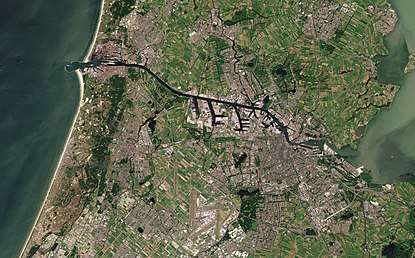

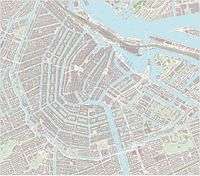
Amsterdam is located in the Western Netherlands, in the province of North Holland, although it is not its capital which is Haarlem. The river Amstel ends in the city centre and connects to a large number of canals that eventually terminate in the IJ. Amsterdam is about 2 metres (6.6 feet) below sea level.[60] The surrounding land is flat as it is formed of large polders. A man-made forest, Amsterdamse Bos, is in the southwest. Amsterdam is connected to the North Sea through the long North Sea Canal.
Amsterdam is intensely urbanised, as is the Amsterdam metropolitan area surrounding the city. Comprising 219.4 square kilometres (84.7 square miles) of land, the city proper has 4,457 inhabitants per km2 and 2,275 houses per km2.[61] Parks and nature reserves make up 12% of Amsterdam's land area.[62]
Water
Amsterdam has more than 100 kilometres (60 miles) of canals, most of which are navigable by boat. The city's three main canals are the Prinsengracht, Herengracht, and Keizersgracht.
In the Middle Ages, Amsterdam was surrounded by a moat, called the Singel, which now forms the innermost ring in the city, and gives the city centre a horseshoe shape. The city is also served by a seaport. It has been compared with Venice, due to its division into about 90 islands, which are linked by more than 1,200 bridges.[63]
Climate
.jpg)
Amsterdam has an oceanic climate (Köppen Cfb)[64] strongly influenced by its proximity to the North Sea to the west, with prevailing westerly winds. While winters are cool and summers warm, temperatures vary year by year. There can occasionally be cold snowy winters and hot humid summers.
Amsterdam, as well as most of the North Holland province, lies in USDA Hardiness zone 8b. Frosts mainly occur during spells of easterly or northeasterly winds from the inner European continent. Even then, because Amsterdam is surrounded on three sides by large bodies of water, as well as having a significant heat-island effect, nights rarely fall below −5 °C (23 °F), while it could easily be −12 °C (10 °F) in Hilversum, 25 kilometres (16 miles) southeast.
Summers are moderately warm with a number of hot days every month. The average daily high in August is 22.1 °C (71.8 °F), and 30 °C (86 °F) or higher is only measured on average on 2.5 days, placing Amsterdam in AHS Heat Zone 2. The record extremes range from −19.7 °C (−3.5 °F) to 36.3 °C (97.3 °F).[65][66][66] Days with more than 1 millimetre (0.04 in) of precipitation are common, on average 133 days per year.
Amsterdam's average annual precipitation is 838 millimetres (33 in).[67] A large part of this precipitation falls as light rain or brief showers. Cloudy and damp days are common during the cooler months of October through March.
| Climate data for Amsterdam Airport Schiphol | |||||||||||||
|---|---|---|---|---|---|---|---|---|---|---|---|---|---|
| Month | Jan | Feb | Mar | Apr | May | Jun | Jul | Aug | Sep | Oct | Nov | Dec | Year |
| Record high °C (°F) | 14.0 (57.2) |
16.6 (61.9) |
24.1 (75.4) |
28.0 (82.4) |
31.5 (88.7) |
33.2 (91.8) |
36.3 (97.3) |
34.5 (94.1) |
31.0 (87.8) |
25.3 (77.5) |
18.2 (64.8) |
15.5 (59.9) |
36.3 (97.3) |
| Average high °C (°F) | 5.8 (42.4) |
6.3 (43.3) |
9.6 (49.3) |
13.5 (56.3) |
17.4 (63.3) |
19.7 (67.5) |
22.0 (71.6) |
22.1 (71.8) |
18.8 (65.8) |
14.5 (58.1) |
9.7 (49.5) |
6.4 (43.5) |
13.8 (56.9) |
| Daily mean °C (°F) | 3.3 (37.9) |
3.4 (38.1) |
6.1 (43.0) |
9.1 (48.4) |
12.9 (55.2) |
15.4 (59.7) |
17.6 (63.7) |
17.5 (63.5) |
14.7 (58.5) |
11.0 (51.8) |
7.1 (44.8) |
4.0 (39.2) |
10.2 (50.3) |
| Average low °C (°F) | 0.8 (33.4) |
0.5 (32.9) |
2.6 (36.7) |
4.6 (40.3) |
8.2 (46.8) |
10.8 (51.4) |
13.0 (55.4) |
12.8 (55.0) |
10.6 (51.1) |
7.5 (45.5) |
4.2 (39.6) |
1.5 (34.7) |
6.4 (43.6) |
| Record low °C (°F) | −16.3 (2.7) |
−19.7 (−3.5) |
−16.7 (1.9) |
−4.7 (23.5) |
−1.1 (30.0) |
2.3 (36.1) |
5.0 (41.0) |
5.0 (41.0) |
2.0 (35.6) |
−3.4 (25.9) |
−8.1 (17.4) |
−14.8 (5.4) |
−19.7 (−3.5) |
| Average precipitation mm (inches) | 66.6 (2.62) |
50.6 (1.99) |
60.6 (2.39) |
40.9 (1.61) |
55.6 (2.19) |
66.0 (2.60) |
76.5 (3.01) |
85.9 (3.38) |
82.4 (3.24) |
89.6 (3.53) |
87.2 (3.43) |
76.3 (3.00) |
838.2 (33.00) |
| Average precipitation days (≥ 1 mm) | 12 | 10 | 11 | 9 | 10 | 10 | 10 | 10 | 12 | 13 | 13 | 13 | 132 |
| Average snowy days | 6 | 6 | 4 | 2 | 0 | 0 | 0 | 0 | 0 | 0 | 3 | 5 | 26 |
| Average relative humidity (%) | 88 | 86 | 83 | 78 | 76 | 78 | 79 | 80 | 83 | 86 | 89 | 90 | 83 |
| Mean monthly sunshine hours | 63.2 | 87.5 | 126.3 | 182.7 | 221.9 | 205.7 | 217.0 | 197.0 | 139.4 | 109.1 | 61.7 | 50.5 | 1,662 |
| Average ultraviolet index | 1 | 1 | 2 | 4 | 5 | 6 | 6 | 5 | 4 | 2 | 1 | 0 | 3 |
| Source: Royal Netherlands Meteorological Institute (1981–2010 normals, snowy days normals for 1971–2000)[68](1971–2000 extremes)[69] and Weather Atlas (UV index)[70] | |||||||||||||
Demographics
Historical population
| Estimated population, 1300–1564 | |||||||||||||||||||||||||
|---|---|---|---|---|---|---|---|---|---|---|---|---|---|---|---|---|---|---|---|---|---|---|---|---|---|
|
| ||||||||||||||||||||||||
| Source: Bureau Monumentenzorg en Archeologie (1300)[71] Ramaer 1921, pp. 11–12, 181 (1400 and 1564) Van Dillen 1929, pp. xxv–xxvi (1514, 1546 and 1557) | |||||||||||||||||||||||||
In 1300, Amsterdam's population was around 1,000 people.[72] While many towns in Holland experienced population decline during the 15th and 16th centuries, Amsterdam's population grew,[73] mainly due to the rise of the profitable Baltic maritime trade after the Burgundian victory in the Dutch–Hanseatic War.[74] Still, the population of Amsterdam was only modest compared to the towns and cities of Flanders and Brabant, which comprised the most urbanised area of the Low Countries.[75]
| Historical population in 10-year intervals, 1590–present | |||||||||||||||||||||||||||||||||||||||||||||||||||||||||||||||||||||||||||||||||||||||||||||||||||||||||||||||||||||||||||||||||||||||||||
|---|---|---|---|---|---|---|---|---|---|---|---|---|---|---|---|---|---|---|---|---|---|---|---|---|---|---|---|---|---|---|---|---|---|---|---|---|---|---|---|---|---|---|---|---|---|---|---|---|---|---|---|---|---|---|---|---|---|---|---|---|---|---|---|---|---|---|---|---|---|---|---|---|---|---|---|---|---|---|---|---|---|---|---|---|---|---|---|---|---|---|---|---|---|---|---|---|---|---|---|---|---|---|---|---|---|---|---|---|---|---|---|---|---|---|---|---|---|---|---|---|---|---|---|---|---|---|---|---|---|---|---|---|---|---|---|---|---|---|---|
|
| ||||||||||||||||||||||||||||||||||||||||||||||||||||||||||||||||||||||||||||||||||||||||||||||||||||||||||||||||||||||||||||||||||||||||||
| Source: Nusteling 1985, p. 240 (1590–1670) Van Leeuwen & Oeppen 1993, p. 87 (1680–1880) Department for Research, Information and Statistics (1890–present) | |||||||||||||||||||||||||||||||||||||||||||||||||||||||||||||||||||||||||||||||||||||||||||||||||||||||||||||||||||||||||||||||||||||||||||
This changed when, during the Dutch Revolt, many people from the Southern Netherlands fled to the North, especially after Antwerp fell to Spanish forces in 1585. Jewish people from Spain, Portugal and Eastern Europe similarly settled in Amsterdam, as did Germans and Scandinavians.[73] In thirty years, Amsterdam's population more than doubled between 1585 and 1610.[76] By 1600, its population was around 50,000.[72] During the 1660s, Amsterdam's population reached 200,000.[77] The city's growth levelled off and the population stabilised around 240,000 for most of the 18th century.[78]
In 1750, Amsterdam was the fourth largest city in western Europe, behind London (676,000), Paris (560,000) and Naples (324,000).[79] This was all the more remarkable as Amsterdam was neither the capital city nor the seat of government of the Dutch Republic, which itself was a much smaller state than England, France or the Ottoman Empire. In contrast to those other metropolises, Amsterdam was also surrounded by large towns such as Leiden (about 67,000), Rotterdam (45,000), Haarlem (38,000), and Utrecht (30,000).[80]
The city's population declined in the early 19th century,[81] dipping under 200,000 in 1820.[82] By the second half of the 19th century, industrialisation spurred renewed growth.[83] Amsterdam's population hit an all-time high of 872,000 in 1959,[84] before declining in the following decades due to government-sponsored suburbanisation to so-called groeikernen (growth centres) such as Purmerend and Almere.[85][86][87][85] Between 1970 and 1980, Amsterdam experienced its sharp population decline, peaking at a net loss of 25,000 people in 1973.[85] By 1985 the city had only 675,570 residents.[88] This was soon followed by reurbanisation and gentrification,[89][85] leading to renewed population growth in the 2010s. Also in the 2010s, much of Amsterdam's population growth was due to immigration to the city.[90] Amsterdam's population is expected to top its previous high in 2019, reaching 873,000.[91]
Immigration
| City of Amsterdam (2018) population by country of origin (includes 2nd generation immigrants)[92] | |
|---|---|
| Country or territory | Population |
| 397,723 (46.57%) | |
| 76,156 (8.92%) | |
| 64,991 (7.61%) | |
| 43,525 (5.10%) | |
| 25,117 (2.94%) | |
| 18,771 (2.20%) | |
| 13,374 (1.57%) | |
| 12,228 (1.43%) | |
| 12,184 (1.43%) | |
| 10,117 (1.18%) | |
| Other | 179,861 (21.05%) |
In the 16th and 17th century non-Dutch immigrants to Amsterdam were mostly Huguenots, Flemings, Sephardi Jews and Westphalians. Huguenots came after the Edict of Fontainebleau in 1685, while the Flemish Protestants came during the Eighty Years' War. The Westphalians came to Amsterdam mostly for economic reasons – their influx continued through the 18th and 19th centuries. Before the Second World War, 10% of the city population was Jewish. Just twenty per cent of them survived the Shoah.[93]
The first mass immigration in the 20th century were by people from Indonesia, who came to Amsterdam after the independence of the Dutch East Indies in the 1940s and 1950s. In the 1960s guest workers from Turkey, Morocco, Italy and Spain emigrated to Amsterdam. After the independence of Suriname in 1975, a large wave of Surinamese settled in Amsterdam, mostly in the Bijlmer area. Other immigrants, including refugees asylum seekers and illegal immigrants, came from Europe, America, Asia, and Africa. In the 1970s and 1980s, many 'old' Amsterdammers moved to 'new' cities like Almere and Purmerend, prompted by the third planological bill of the Dutch government. This bill promoted suburbanisation and arranged for new developments in so-called "groeikernen", literally cores of growth. Young professionals and artists moved into neighbourhoods de Pijp and the Jordaan abandoned by these Amsterdammers. The non-Western immigrants settled mostly in the social housing projects in Amsterdam-West and the Bijlmer. Today, people of non-Western origin make up approximately one-third of the population of Amsterdam, and more than 50% of the city' s children.[94][95][96] Ethnic Dutch (as defined by the Dutch census) now make up a minority of the total population, although by far the largest one. Only one in three inhabitants under 15 is an autochtoon, or a person who has two parents of Dutch origin.[97] Segregation along ethnic lines is clearly visible, with people of non-Western origin, considered a separate group by Statistics Netherlands, concentrating in specific neighbourhoods especially in Nieuw-West, Zeeburg, Bijlmer and in certain areas of Amsterdam-Noord.[98][99]
In 2000, Christians formed the largest religious group in the city (17% of the population). The next largest religion was Islam (14%), most of whose followers were Sunni.[100][101]
Religion
Religion in Amsterdam (2015)[102]
In 1578, the largely Roman Catholic city of Amsterdam joined the revolt against Spanish rule,[103] late in comparison to other major northern Dutch cities.[104] Roman Catholic priests were driven out of the city.[103] Following the Dutch takeover, all churches were converted to Protestant worship.[105] Calvinism was declared the main religion,[104] and although Catholicism was not forbidden and priests allowed to serve, the Catholic hierarchy was prohibited. This led to the establishment of schuilkerken, covert religious buildings that were hidden in pre-existing buildings. Catholics, some Jewish and dissenting Protestants worshiped in such buildings.[106] A large influx of foreigners of many religions came to 17th-century Amsterdam, in particular Sefardic Jews from Spain and Portugal,[107][108] Huguenots from France,[109] Lutherans, Mennonites, and Protestants from across the Netherlands.[110] This led to the establishment of many non-Dutch-speaking churches. In 1603, the Jewish received permission to practice their religion. In 1639, the first synagogue was consecrated.[111] The Jews came to call the town Jerusalem of the West.[112]
As they became established in the city, other Christian denominations used converted Catholic chapels to conduct their own services. The oldest English-language church congregation in the world outside the United Kingdom is found at the Begijnhof. Regular services there are still offered in English under the auspices of the Church of Scotland.[113] Being Calvinists, the Huguenots soon integrated into the Dutch Reformed Church, though often retaining their own congregations. Some, commonly referred by the moniker 'Walloon', are recognisable today as they offer occasional services in French.
In the second half of the 17th century, Amsterdam experienced an influx of Ashkenazim, Jews from Central and Eastern Europe. Jews often fled the pogroms in those areas. The first Ashkenazis who arrived in Amsterdam were refugees from the Khmelnytsky Uprising in Ukraine and the Thirty Years' War, which devastated much of Central Europe. They not only founded their own synagogues, but had a strong influence on the 'Amsterdam dialect' adding a large Yiddish local vocabulary.[114]
Despite an absence of an official Jewish ghetto, most Jews preferred to live in the eastern part of the old medieval heart of the city. The main street of this Jewish neighbourhood was the Jodenbreestraat. The neighbourhood comprised the Waterlooplein and the Nieuwmarkt.[114][115] Buildings in this neighbourhood fell into disrepair after the Second World War,[116] and a large section of the neighbourhood was demolished during the construction of the subway. This led to riots, and as a result the original plans for large-scale reconstruction were abandoned.[117][118] The neighbourhood was rebuilt with smaller-scale residence buildings on the basis of its original layout.[119]
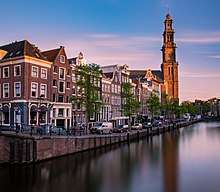
Catholic churches in Amsterdam have been constructed since the restoration of the episcopal hierarchy in 1853.[120] One of the principal architects behind the city's Catholic churches, Cuypers, was also responsible for the Amsterdam Central station and the Rijksmuseum.[121][122]
In 1924, the Roman Catholic Church of the Netherlands hosted the International Eucharistic Congress in Amsterdam,[123] and numerous Catholic prelates visited the city, where festivities were held in churches and stadiums.[124] Catholic processions on the public streets, however, were still forbidden under law at the time.[125] Only in the 20th century was Amsterdam's relation to Catholicism normalised,[126] but despite its far larger population size, the episcopal see of the city was placed in the provincial town of Haarlem.[127]
In recent times, religious demographics in Amsterdam have been changed by immigration from former colonies. Hinduism has been introduced from the Hindu diaspora from Suriname[128] and several distinct branches of Islam have been brought from various parts of the world.[129] Islam is now the largest non-Christian religion in Amsterdam.[102] The large community of Ghanaian immigrants have established African churches,[130] often in parking garages in the Bijlmer area.[131]
Diversity and immigration
Amsterdam experienced an influx of religions and cultures after the Second World War. With 180 different nationalities,[132] Amsterdam is home to one of the widest varieties of nationalities of any city in the world.[133] The proportion of the population of immigrant origin in the city proper is about 50%[134] and 88% of the population are Dutch citizens.[135]
Amsterdam has been one of the municipalities in the Netherlands which provided immigrants with extensive and free Dutch-language courses, which have benefited many immigrants.[136]
Cityscape and architecture

Amsterdam fans out south from the Amsterdam Centraal railway station and Damrak, the main street off the station. The oldest area of the town is known as De Wallen (English: "The Quays"). It lies to the east of Damrak and contains the city's famous red light district. To the south of De Wallen is the old Jewish quarter of Waterlooplein.
The medieval and colonial age canals of Amsterdam, known as grachten, embraces the heart of the city where homes have interesting gables. Beyond the Grachtengordel are the former working class areas of Jordaan and de Pijp. The Museumplein with the city's major museums, the Vondelpark, a 19th-century park named after the Dutch writer Joost van den Vondel, and the Plantage neighbourhood, with the zoo, are also located outside the Grachtengordel.
Several parts of the city and the surrounding urban area are polders. This can be recognised by the suffix -meer which means lake, as in Aalsmeer, Bijlmermeer, Haarlemmermeer, and Watergraafsmeer.
Canals


The Amsterdam canal system is the result of conscious city planning.[137] In the early 17th century, when immigration was at a peak, a comprehensive plan was developed that was based on four concentric half-circles of canals with their ends emerging at the IJ bay. Known as the Grachtengordel, three of the canals were mostly for residential development: the Herengracht (where "Heren" refers to Heren Regeerders van de stad Amsterdam (ruling lords of Amsterdam), and gracht means canal, so the name can be roughly translated as "Canal of the Lords"), Keizersgracht (Emperor's Canal), and Prinsengracht (Prince's Canal).[138] The fourth and outermost canal is the Singelgracht, which is often not mentioned on maps, because it is a collective name for all canals in the outer ring. The Singelgracht should not be confused with the oldest and innermost canal, the Singel.
The canals served for defence, water management and transport. The defences took the form of a moat and earthen dikes, with gates at transit points, but otherwise no masonry superstructures.[139] The original plans have been lost, so historians, such as Ed Taverne, need to speculate on the original intentions: it is thought that the considerations of the layout were purely practical and defensive rather than ornamental.[140]
Construction started in 1613 and proceeded from west to east, across the breadth of the layout, like a gigantic windshield wiper as the historian Geert Mak calls it – and not from the centre outwards, as a popular myth has it. The canal construction in the southern sector was completed by 1656. Subsequently, the construction of residential buildings proceeded slowly. The eastern part of the concentric canal plan, covering the area between the Amstel river and the IJ bay, has never been implemented. In the following centuries, the land was used for parks, senior citizens' homes, theatres, other public facilities, and waterways without much planning.[141] Over the years, several canals have been filled in, becoming streets or squares, such as the Nieuwezijds Voorburgwal and the Spui.[142]
Expansion

After the development of Amsterdam's canals in the 17th century, the city did not grow beyond its borders for two centuries. During the 19th century, Samuel Sarphati devised a plan based on the grandeur of Paris and London at that time. The plan envisaged the construction of new houses, public buildings and streets just outside the Grachtengordel. The main aim of the plan, however, was to improve public health. Although the plan did not expand the city, it did produce some of the largest public buildings to date, like the Paleis voor Volksvlijt.[143][144][145]
Following Sarphati, civil engineers Jacobus van Niftrik and Jan Kalff designed an entire ring of 19th-century neighbourhoods surrounding the city's centre, with the city preserving the ownership of all land outside the 17th-century limit, thus firmly controlling development.[146] Most of these neighbourhoods became home to the working class.[147]
In response to overcrowding, two plans were designed at the beginning of the 20th century which were very different from anything Amsterdam had ever seen before: Plan Zuid, designed by the architect Berlage, and West. These plans involved the development of new neighbourhoods consisting of housing blocks for all social classes.[148][149]
After the Second World War, large new neighbourhoods were built in the western, southeastern, and northern parts of the city. These new neighbourhoods were built to relieve the city's shortage of living space and give people affordable houses with modern conveniences. The neighbourhoods consisted mainly of large housing blocks situated among green spaces, connected to wide roads, making the neighbourhoods easily accessible by motor car. The western suburbs which were built in that period are collectively called the Westelijke Tuinsteden. The area to the southeast of the city built during the same period is known as the Bijlmer.[150][151]
Architecture
Amsterdam has a rich architectural history. The oldest building in Amsterdam is the Oude Kerk (English: Old Church), at the heart of the Wallen, consecrated in 1306.[152] The oldest wooden building is Het Houten Huys[153] at the Begijnhof. It was constructed around 1425 and is one of only two existing wooden buildings. It is also one of the few examples of Gothic architecture in Amsterdam. The oldest stone building of the Netherlands, The Moriaan is build in 's-Hertogenbosch.
In the 16th century, wooden buildings were razed and replaced with brick ones. During this period, many buildings were constructed in the architectural style of the Renaissance. Buildings of this period are very recognisable with their stepped gable façades, which is the common Dutch Renaissance style. Amsterdam quickly developed its own Renaissance architecture. These buildings were built according to the principles of the architect Hendrick de Keyser.[154] One of the most striking buildings designed by Hendrick de Keyer is the Westerkerk. In the 17th century baroque architecture became very popular, as it was elsewhere in Europe. This roughly coincided with Amsterdam's Golden Age. The leading architects of this style in Amsterdam were Jacob van Campen, Philips Vingboons and Daniel Stalpaert.[155]
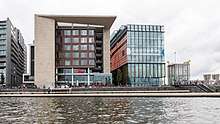
Philip Vingboons designed splendid merchants' houses throughout the city. A famous building in baroque style in Amsterdam is the Royal Palace on Dam Square. Throughout the 18th century, Amsterdam was heavily influenced by French culture. This is reflected in the architecture of that period. Around 1815, architects broke with the baroque style and started building in different neo-styles.[156] Most Gothic style buildings date from that era and are therefore said to be built in a neo-gothic style. At the end of the 19th century, the Jugendstil or Art Nouveau style became popular and many new buildings were constructed in this architectural style. Since Amsterdam expanded rapidly during this period, new buildings adjacent to the city centre were also built in this style. The houses in the vicinity of the Museum Square in Amsterdam Oud-Zuid are an example of Jugendstil. The last style that was popular in Amsterdam before the modern era was Art Deco. Amsterdam had its own version of the style, which was called the Amsterdamse School. Whole districts were built this style, such as the Rivierenbuurt.[157] A notable feature of the façades of buildings designed in Amsterdamse School is that they are highly decorated and ornate, with oddly shaped windows and doors.
The old city centre is the focal point of all the architectural styles before the end of the 19th century. Jugendstil and Georgian are mostly found outside the city's centre in the neighbourhoods built in the early 20th century, although there are also some striking examples of these styles in the city centre. Most historic buildings in the city centre and nearby are houses, such as the famous merchants' houses lining the canals.
Parks and recreational areas
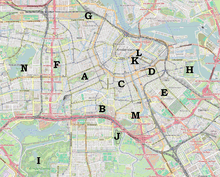
- A: Vondelpark
- B: Beatrixpark
- C: Sarphatipark
- D: Oosterpark
- E: Park Frankendael
- F: Rembrandtpark
- G: Westerpark
- H: Flevopark
- I: Amsterdamse Bos
- J: Amstelpark
- K: Hortus Botanicus
- L: Wertheimerpark
- M: Martin Luther Kingpark
- N: Sloterpark
Amsterdam has many parks, open spaces, and squares throughout the city. The Vondelpark, the largest park in the city, is located in the Oud-Zuid neighbourhood and is named after the 17th-century Amsterdam author Joost van den Vondel. Yearly, the park has around 10 million visitors. In the park is an open-air theatre, a playground and several horeca facilities. In the Zuid borough, is the Beatrixpark, named after Queen Beatrix. Between Amsterdam and Amstelveen is the Amsterdamse Bos ("Amsterdam Forest"), the largest recreational area in Amsterdam. Annually, almost 4.5 million people visit the park, which has a size of 1.000 hectares and is approximately three times the size of Central Park.[158] The Amstelpark in the Zuid borough houses the Rieker windmill, which dates to 1636. Other parks include the Sarphatipark in the De Pijp neighbourhood, the Oosterpark in the Oost borough and the Westerpark in the Westerpark neighbourhood. The city has three beaches: Nemo Beach, Citybeach "Het stenen hoofd" (Silodam) and Blijburg, all located in the Centrum borough.
The city has many open squares (plein in Dutch). The namesake of the city as the site of the original dam, Dam Square, is the main city square and has the Royal Palace and National Monument. Museumplein hosts various museums, including the Rijksmuseum, Van Gogh Museum, and Stedelijk Museum. Other squares include Rembrandtplein, Muntplein, Nieuwmarkt, Leidseplein, Spui, and Waterlooplein. Also, near to Amsterdam is the Nekkeveld estate conservation project.
Economy
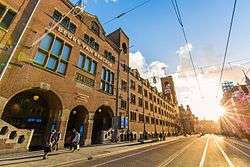
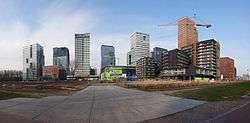
Amsterdam is the financial and business capital of the Netherlands.[159] According to the 2007 European Cities Monitor (ECM) - an annual location survey of Europe’s leading companies carried out by global real estate consultant Cushman & Wakefield - Amsterdam is one of the top European cities in which to locate an international business, ranking fifth in the survey.[160] with the survey determining London, Paris, Frankfurt and Barcelona as the four European cities surpassing Amsterdam in this regard.
A substantial number of large corporations and banks' headquarters are located in the Amsterdam area, including: AkzoNobel, Heineken International, ING Group, ABN AMRO, TomTom, Delta Lloyd Group, Booking.com and Philips. Although many small offices remain along the historic canals, centrally based companies have increasingly relocated outside Amsterdam's city centre. Consequently, the Zuidas (English: South Axis) has become the new financial and legal hub of Amsterdam,[161] with the country's five largest law firms and a number of subsidiaries of large consulting firms, such as Boston Consulting Group and Accenture, as well as the World Trade Centre (Amsterdam) located in the Zuidas district. In addition to the Zuidas, there are three smaller financial districts in Amsterdam:
- around Amsterdam Sloterdijk railway station. Where one can find the offices of several newspapers, such as De Telegraaf. as well as those of Deloitte, the Gemeentelijk Vervoerbedrijf (municipal public transport company), and the Dutch tax offices (Belastingdienst);
- around the Johan Cruyff Arena in Amsterdam Zuidoost;
- around the Amstel railway station in the Amsterdam-Oost district to the east of the historical city. Amsterdam's tallest building, the Rembrandt Tower, is situated here.[162] As are the headquarters of Philips, the Dutch multinational conglomerate.[163]
The adjoining municipality of Amstelveen is the location of KPMG International's global headquarters. Other non-Dutch companies have chosen to settle in communities surrounding Amsterdam since they allow freehold property ownership, whereas Amsterdam retains ground rent.
Port of Amsterdam
The Port of Amsterdam is the fourth largest port in Europe, the 38th largest port in the world and the second largest port in the Netherlands by metric tons of cargo. In 2014 the Port of Amsterdam had a cargo throughput of 97,4 million tons of cargo, which was mostly bulk cargo. Amsterdam has the biggest cruise port in the Netherlands with more than 150 cruise ships every year. In 2019 the new lock in IJmuiden will open; the port will then be able to grow to 125 million tonnes in capacity.
The Amsterdam Stock Exchange (AEX), now part of Euronext, is the world's oldest stock exchange and is one of Europe's largest bourses. It is near Dam Square in the city centre.
Together with Eindhoven (Brainport) and Rotterdam (Seaport), Amsterdam (Airport) forms the foundation of the Dutch economy.[164]
Tourism
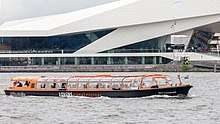

Amsterdam is one of the most popular tourist destinations in Europe, receiving more than 4.63 million international visitors annually, this is excluding the 16 million day-trippers visiting the city every year.[165] The number of visitors has been growing steadily over the past decade. This can be attributed to an increasing number of European visitors. Two-thirds of the hotels are located in the city's centre. Hotels with 4 or 5 stars contribute 42% of the total beds available and 41% of the overnight stays in Amsterdam. The room occupation rate was 85% in 2017, up from 78% in 2006. [166] [167] The majority of tourists (74%) originate from Europe. The largest group of non-European visitors come from the United States, accounting for 14% of the total.[167] Certain years have a theme in Amsterdam to attract extra tourists. For example, the year 2006 was designated "Rembrandt 400", to celebrate the 400th birthday of Rembrandt van Rijn. Some hotels offer special arrangements or activities during these years. The average number of guests per year staying at the four campsites around the city range from 12,000 to 65,000.[167]
De Wallen (Red-light district)
De Wallen, also known as Walletjes or Rosse Buurt, is a designated area for legalised prostitution and is Amsterdam's largest and most well known red-light district. This neighbourhood has become a famous attraction for tourists. It consists of a network of roads and alleys containing several hundred small, one-room apartments rented by sex workers who offer their services from behind a window or glass door, typically illuminated with red lights. In recent years the city government has been closing and repurposing the famous red light district windows in an effort to clean up the area and reduce the amount of party and sex tourism.
Retail
Shops in Amsterdam range from large high end department stores such as De Bijenkorf founded in 1870 to small specialty shops. Amsterdam's high-end shops are found in the streets P.C. Hooftstraat[169] and Cornelis Schuytstraat, which are located in the vicinity of the Vondelpark. One of Amsterdam's busiest high streets is the narrow, medieval Kalverstraat in the heart of the city. Other shopping areas include the Negen Straatjes and Haarlemmerdijk and Haarlemmerstraat. Negen Straatjes are nine narrow streets within the Grachtengordel, the concentric canal system of Amsterdam. The Negen Straatjes differ from other shopping districts with the presence of a large diversity of privately owned shops. The Haarlemmerstraat and Haarlemmerdijk were voted best shopping street in the Netherlands in 2011. These streets have as the Negen Straatjes a large diversity of privately owned shops. But as the Negen Straatjes are dominated by fashion stores the Haarlemmerstraat and Haarlemmerdijk offer a very wide variety of all kinds of stores, just to name some specialties: candy and other food related stores, lingerie, sneakers, wedding clothing, interior shops, books, Italian deli's, racing and mountain bikes, skatewear, etc.
The city also features a large number of open-air markets such as the Albert Cuyp Market, Westerstraat-markt, Ten Katemarkt, and Dappermarkt. Some of these markets are held on a daily basis, like the Albert Cuypmarkt and the Dappermarkt. Others, like the Westerstraatmarkt, are held on a weekly basis.
Fashion
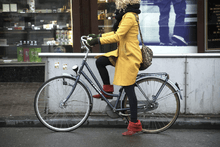
Several fashion brands and designers are based in Amsterdam. Fashion designers include Iris van Herpen,[170] Mart Visser, Viktor & Rolf, Marlies Dekkers and Frans Molenaar. Fashion models like Yfke Sturm, Doutzen Kroes and Kim Noorda started their careers in Amsterdam. Amsterdam has its garment centre in the World Fashion Center. Fashion photographers Inez van Lamsweerde and Vinoodh Matadin were born in Amsterdam.[171]
Culture
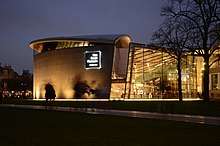
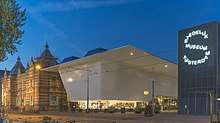
During the later part of the 16th-century, Amsterdam's Rederijkerskamer (Chamber of rhetoric) organised contests between different Chambers in the reading of poetry and drama.[172][173] In 1637, Schouwburg, the first theatre in Amsterdam was built, opening on 3 January 1638.[174] The first ballet performances in the Netherlands were given in Schouwburg in 1642 with the Ballet of the Five Senses.[175][176] In the 18th century, French theatre became popular. While Amsterdam was under the influence of German music in the 19th century there were few national opera productions; the Hollandse Opera of Amsterdam was built in 1888 for the specific purpose of promoting Dutch opera.[177] In the 19th century, popular culture was centred on the Nes area in Amsterdam (mainly vaudeville and music-hall). An improved metronome was invented in 1812 by Dietrich Nikolaus Winkel.[178] The Rijksmuseum (1885) and Stedelijk Museum (1895) were built and opened.[179][180] In 1888, the Concertgebouworkest orchestra was established.[181] With the 20th century came cinema, radio and television. Though most studios are located in Hilversum and Aalsmeer, Amsterdam's influence on programming is very strong. Many people who work in the television industry live in Amsterdam. Also, the headquarters of the Dutch SBS Broadcasting Group is located in Amsterdam.[182]
Museums
The most important museums of Amsterdam are located on the Museumplein (Museum Square), located at the southwestern side of the Rijksmuseum. It was created in the last quarter of the 19th century on the grounds of the former World's fair. The northeastern part of the square is bordered by the very large Rijksmuseum. In front of the Rijksmuseum on the square itself is a long, rectangular pond. This is transformed into an ice rink in winter.[183] The northwestern part of the square is bordered by the Van Gogh Museum, Stedelijk Museum, House of Bols Cocktail & Genever Experience and Coster Diamonds. The southwestern border of the Museum Square is the Van Baerlestraat, which is a major thoroughfare in this part of Amsterdam. The Concertgebouw is situated across this street from the square. To the southeast of the square are situated a number of large houses, one of which contains the American consulate. A parking garage can be found underneath the square, as well as a supermarket. The Museumplein is covered almost entirely with a lawn, except for the northeastern part of the square which is covered with gravel. The current appearance of the square was realised in 1999, when the square was remodelled. The square itself is the most prominent site in Amsterdam for festivals and outdoor concerts, especially in the summer. Plans were made in 2008 to remodel the square again, because many inhabitants of Amsterdam are not happy with its current appearance.[184]
The Rijksmuseum possesses the largest and most important collection of classical Dutch art.[185] It opened in 1885. Its collection consists of nearly one million objects.[186] The artist most associated with Amsterdam is Rembrandt, whose work, and the work of his pupils, is displayed in the Rijksmuseum. Rembrandt's masterpiece The Night Watch is one of top pieces of art of the museum. It also houses paintings from artists like Bartholomeus van der Helst, Johannes Vermeer, Frans Hals, Ferdinand Bol, Albert Cuyp, Jacob van Ruisdael and Paulus Potter. Aside from paintings, the collection consists of a large variety of decorative art. This ranges from Delftware to giant doll-houses from the 17th century. The architect of the gothic revival building was P.J.H. Cuypers. The museum underwent a 10-year, 375 million euro renovation starting in 2003. The full collection was reopened to the public on 13 April 2013 and the Rijksmuseum has remained the most visited museum in Amsterdam with 2.2 million visitors in 2016 and 2.16 million in 2017.[187]
Van Gogh lived in Amsterdam for a short while and there is a museum dedicated to his work. The museum is housed in one of the few modern buildings in this area of Amsterdam. The building was designed by Gerrit Rietveld. This building is where the permanent collection is displayed. A new building was added to the museum in 1999. This building, known as the performance wing, was designed by Japanese architect Kisho Kurokawa. Its purpose is to house temporary exhibitions of the museum.[188][189] Some of Van Gogh's most famous paintings, like The Potato Eaters and Sunflowers, are in the collection.[190] The Van Gogh museum is the second most visited museum in Amsterdam, not far behind the Rijksmuseum in terms of the number of visits, being approximately 2.1 million in 2016,[191] for example.
Next to the Van Gogh museum stands the Stedelijk Museum. This is Amsterdam's most important museum of modern art. The museum is as old as the square it borders and was opened in 1895. The permanent collection consists of works of art from artists like Piet Mondriaan, Karel Appel, and Kazimir Malevich. After renovations lasting several years the museum opened in September 2012 with a new composite extension that has been called 'The Bathtub' due to its resemblance to one.
Amsterdam contains many other museums throughout the city. They range from small museums such as the Verzetsmuseum (Resistance Museum), the Anne Frank House, and the Rembrandt House Museum, to the very large, like the Tropenmuseum (Museum of the Tropics), Amsterdam Museum (formerly known as Amsterdam Historical Museum), Hermitage Amsterdam (a dependency of the Hermitage Museum in Saint Petersburg) and the Joods Historisch Museum (Jewish Historical Museum). The modern-styled Nemo is dedicated to child-friendly science exhibitions.
Music
.jpg)
Amsterdam's musical culture includes a large collection of songs which treat the city nostalgically and lovingly. The 1949 song "Aan de Amsterdamse grachten" ("On the canals of Amsterdam") was performed and recorded by many artists, including John Kraaijkamp Sr.; the best-known version is probably that by Wim Sonneveld (1962). In the 1950s Johnny Jordaan rose to fame with "Geef mij maar Amsterdam" ("I prefer Amsterdam"), which praises the city above all others (explicitly Paris); Jordaan sang especially about his own neighbourhood, the Jordaan ("Bij ons in de Jordaan"). Colleagues and contemporaries of Johnny include Tante Leen and Manke Nelis. Another notable Amsterdam song is "Amsterdam" by Jacques Brel (1964).[192] A 2011 poll by Amsterdam newspaper Het Parool that Trio Bier's "Oude Wolf" was voted "Amsterdams lijflied".[193] Notable Amsterdam bands from the modern era include the Osdorp Posse and The Ex.
AFAS Live (formerly known as the Heineken Music Hall) is a concert hall located near the Johan Cruyff Arena (known as the Amsterdam Arena until 2018). Its main purpose is to serve as a podium for pop concerts for big audiences. Many famous international artists have performed there. Two other notable venues, Paradiso and the Melkweg are located near the Leidseplein. Both focus on broad programming, ranging from indie rock to hip hop, R&B, and other popular genres. Other more subcultural music venues are OCCII, OT301, De Nieuwe Anita, Winston Kingdom and Zaal 100. Jazz has a strong following in Amsterdam, with the Bimhuis being the premier venue. In 2012, Ziggo Dome was opened, also near Amsterdam Arena, a state-of-the-art indoor music arena.
AFAS Live is also host to many electronic dance music festivals, alongside many other venues. Armin van Buuren and Tiesto, some of the world's leading Trance DJ's hail from the Netherlands and perform frequently in Amsterdam. Each year in October, the city hosts the Amsterdam Dance Event (ADE) which is one of the leading electronic music conferences and one of the biggest club festivals for electronic music in the world, attracting over 350,000 visitors each year.[194] Another popular dance festival is 5daysoff, which takes place in the venues Paradiso and Melkweg. In summer time there are several big outdoor dance parties in or nearby Amsterdam, such as Awakenings, Dance Valley, Mystery Land, Loveland, A Day at the Park, Welcome to the Future, and Valtifest.
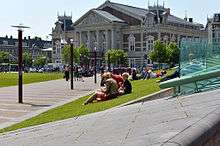
Amsterdam has a world-class symphony orchestra, the Royal Concertgebouw Orchestra. Their home is the Concertgebouw, which is across the Van Baerlestraat from the Museum Square. It is considered by critics to be a concert hall with some of the best acoustics in the world. The building contains three halls, Grote Zaal, Kleine Zaal, and Spiegelzaal. Some nine hundred concerts and other events per year take place in the Concertgebouw, for a public of over 700,000, making it one of the most-visited concert halls in the world.[195] The opera house of Amsterdam is situated adjacent to the city hall. Therefore, the two buildings combined are often called the Stopera, (a word originally coined by protesters against it very construction: Stop the Opera[-house]). This huge modern complex, opened in 1986, lies in the former Jewish neighbourhood at Waterlooplein next to the river Amstel. The Stopera is the homebase of Dutch National Opera, Dutch National Ballet and the Holland Symfonia. Muziekgebouw aan 't IJ is a concert hall, which is situated in the IJ near the central station. Its concerts perform mostly modern classical music. Located adjacent to it, is the Bimhuis, a concert hall for improvised and Jazz music.
Performing arts
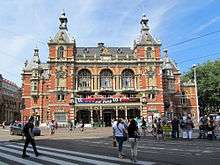
Amsterdam has three main theatre buildings.
The Stadsschouwburg at the Leidseplein is the home base of Toneelgroep Amsterdam. The current building dates from 1894. Most plays are performed in the Grote Zaal (Great Hall). The normal programme of events encompasses all sorts of theatrical forms. The Stadsschouwburg is currently being renovated and expanded. The third theatre space, to be operated jointly with next door Melkweg, will open in late 2009 or early 2010.
The Dutch National Opera and Ballet (formerly known as Het Muziektheater), dating from 1986, is the principal opera house and home to Dutch National Opera and Dutch National Ballet. Royal Theatre Carré was built as a permanent circus theatre in 1887 and is currently mainly used for musicals, cabaret performances and pop concerts.
The recently re-opened DeLaMar Theater houses the more commercial plays and musicals. A new theatre has also moved into Amsterdam scene in 2014, joining other established venues: Theater Amsterdam is situated in the west part of Amsterdam, on the Danzigerkade. It is housed in a modern building with a panoramic view over the harbour. The theatre is the first ever purpose-built venue to showcase a single play entitled ANNE, the play based on Anne Frank's life.
On the east side of town, there is a small theatre in a converted bath house, the Badhuistheater. The theatre often has English programming.
The Netherlands has a tradition of cabaret or kleinkunst, which combines music, storytelling, commentary, theatre and comedy. Cabaret dates back to the 1930s and artists like Wim Kan, Wim Sonneveld and Toon Hermans were pioneers of this form of art in the Netherlands. In Amsterdam is the Kleinkunstacademie (English: Cabaret Academy). Contemporary popular artists are Youp van 't Hek, Freek de Jonge, Herman Finkers, Hans Teeuwen, Theo Maassen, Herman van Veen, Najib Amhali, Raoul Heertje, Jörgen Raymann, Brigitte Kaandorp and Comedytrain. The English spoken comedy scene was established with the founding of Boom Chicago in 1993. They have their own theatre at Leidseplein.
Nightlife

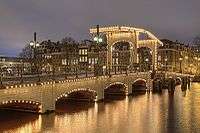
Amsterdam is famous for its vibrant and diverse nightlife. Amsterdam has many cafés (bars). They range from large and modern to small and cozy. The typical Bruine Kroeg (brown café) breathe a more old fashioned atmosphere with dimmed lights, candles, and somewhat older clientele. These brown cafés mostly offer a wide range of local and international artesanal beers. Most cafés have terraces in summertime. A common sight on the Leidseplein during summer is a square full of terraces packed with people drinking beer or wine. Many restaurants can be found in Amsterdam as well. Since Amsterdam is a multicultural city, a lot of different ethnic restaurants can be found. Restaurants range from being rather luxurious and expensive to being ordinary and affordable. Amsterdam also possesses many discothèques. The two main nightlife areas for tourists are the Leidseplein and the Rembrandtplein. The Paradiso, Melkweg and Sugar Factory are cultural centres, which turn into discothèques on some nights. Examples of discothèques near the Rembrandtplein are the Escape, Air, John Doe and Club Abe. Also noteworthy are Panama, Hotel Arena (East), TrouwAmsterdam and Studio 80. In recent years '24-hour' clubs opened their doors, most notably Radion De School, Shelter and Marktkantine. Bimhuis located near the Central Station, with its rich programming hosting the best in the field is considered one of the best jazz clubs in the world. The Reguliersdwarsstraat is the main street for the LGBT community and nightlife.
Festivals
.jpg)
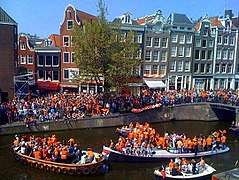
In 2008, there were 140 festivals and events in Amsterdam.[196]
Famous festivals and events in Amsterdam include: Koningsdag (which was named Koninginnedag until the crowning of King Willem-Alexander in 2013) (King's Day – Queen's Day); the Holland Festival for the performing arts; the yearly Prinsengrachtconcert (classical concerto on the Prinsen canal) in August; the 'Stille Omgang' (a silent Roman Catholic evening procession held every March); Amsterdam Gay Pride; The Cannabis Cup; and the Uitmarkt. On Koningsdag—that is held each year on 27 April—hundreds of thousands of people travel to Amsterdam to celebrate with the city's residents. The entire city becomes overcrowded with people buying products from the freemarket, or visiting one of the many music concerts.
The yearly Holland Festival attracts international artists and visitors from all over Europe. Amsterdam Gay Pride is a yearly local LGBT parade of boats in Amsterdam's canals, held on the first Saturday in August.[197] The annual Uitmarkt is a three-day cultural event at the start of the cultural season in late August. It offers previews of many different artists, such as musicians and poets, who perform on podia.[198]
Sports
Amsterdam is home of the Eredivisie football club AFC Ajax. The stadium Johan Cruyff Arena is the home of Ajax. It is located in the south-east of the city next to the new Amsterdam Bijlmer ArenA railway station. Before moving to their current location in 1996, Ajax played their regular matches in the now demolished De Meer Stadion in the eastern part of the city [199] or in the Olympic Stadium. In 1928, Amsterdam hosted the Summer Olympics. The Olympic Stadium built for the occasion has been completely restored and is now used for cultural and sporting events, such as the Amsterdam Marathon.[200] In 1920, Amsterdam assisted in hosting some of the sailing events for the Summer Olympics held in neighbouring Antwerp, Belgium by hosting events at Buiten IJ.
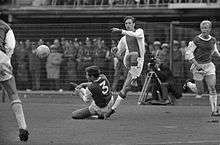
The city holds the Dam to Dam Run, a 16-kilometre (10 mi) race from Amsterdam to Zaandam, as well as the Amsterdam Marathon. The ice hockey team Amstel Tijgers play in the Jaap Eden ice rink. The team competes in the Dutch ice hockey premier league. Speed skating championships have been held on the 400-metre lane of this ice rink.
Amsterdam holds two American football franchises: the Amsterdam Crusaders and the Amsterdam Panthers. The Amsterdam Pirates baseball team competes in the Dutch Major League. There are three field hockey teams: Amsterdam, Pinoké and Hurley, who play their matches around the Wagener Stadium in the nearby city of Amstelveen. The basketball team MyGuide Amsterdam competes in the Dutch premier division and play their games in the Sporthallen Zuid.[201]
There is one rugby club in Amsterdam, which also hosts sports training classes such as RTC (Rugby Talenten Centrum or Rugby Talent Centre) and the National Rugby stadium.
Since 1999, the city of Amsterdam honours the best sportsmen and women at the Amsterdam Sports Awards. Boxer Raymond Joval and field hockey midfielder Carole Thate were the first to receive the awards, in 1999.
Amsterdam hosted the World Gymnaestrada in 1991 and will do so again in 2023.[202]
Politics

The city of Amsterdam is a municipality under the Dutch Municipalities Act. It is governed by a directly elected municipal council, a municipal executive board and a mayor. Since 1981, the municipality of Amsterdam has gradually been divided into semi-autonomous boroughs, called stadsdelen or 'districts'. Over time, a total of 15 boroughs were created. In May 2010, under a major reform, the number of Amsterdam boroughs was reduced to eight: Amsterdam-Centrum covering the city centre including the canal belt, Amsterdam-Noord consisting of the neighbourhoods north of the IJ lake, Amsterdam-Oost in the east, Amsterdam-Zuid in the south, Amsterdam-West in the west, Amsterdam Nieuw-West in the far west, Amsterdam Zuidoost in the southeast, and Westpoort covering the Port of Amsterdam area.[203]
City government
As with all Dutch municipalities, Amsterdam is governed by a directly elected municipal council, a municipal executive board and a government appointed[204] mayor (burgemeester). The mayor is a member of the municipal executive board, but also has individual responsibilies in maintaining public order. On 27 June 2018, Femke Halsema (former member of House of Representatives for GroenLinks from 1998 to 2011) was appointed as the first woman to be Mayor of Amsterdam by the King's Commissioner of North Holland for a six-year term after being nominated by the Amsterdam municipal council and began serving a six-year term on 12 July 2018. She replaces Eberhard van der Laan (Labour Party) who was the Mayor of Amsterdam from 2010 until his death in October 2017. After the 2014 municipal council elections, a governing majority of D66, VVD and SP was formed – the first coalition without the Labour Party since World War II.[205] Next to the Mayor, the municipal executive board consists of eight wethouders ('alderpersons') appointed by the municipal council: four D66 alderpersons, two VVD alderpersons and two SP alderpersons.[206]
On 18 September 2017, it was announced by Eberhard van der Laan in an open letter to Amsterdam citizens that Kajsa Ollongren would take up his office as acting Mayor of Amsterdam with immediate effect due to ill health.[207] Ollongren was succeeded as acting Mayor by Eric van der Burg on 26 October 2017 and by Jozias van Aartsen on 4 December 2017.
Unlike most other Dutch municipalities, Amsterdam is subdivided into eight boroughs, called stadsdelen or 'districts', a system that was implemented gradually in the 1980s to improve local governance. The boroughs are responsible for many activities that had previously been run by the central city. In 2010, the number of Amsterdam boroughs reached fifteen. Fourteen of those had their own district council (deelraad), elected by a popular vote. The fifteenth, Westpoort, covers the harbour of Amsterdam and had very few residents. Therefore, it was governed by the central municipal council.
Under the borough system, municipal decisions are made at borough level, except for those affairs pertaining to the whole city such as major infrastructure projects, which are the jurisdiction of the central municipal authorities. In 2010, the borough system was restructured, in which many smaller boroughs merged into larger boroughs. In 2014, under a reform of the Dutch Municipalities Act, the Amsterdam boroughs lost much of their autonomous status, as their district councils were abolished.
The municipal council of Amsterdam voted to maintain the borough system by replacing the district councils with smaller, but still directly elected district committees (bestuurscommissies). Under a municipal ordinance, the new district committees were granted responsibilities through delegation of regulatory and executive powers by the central municipal council.

Metropolitan area
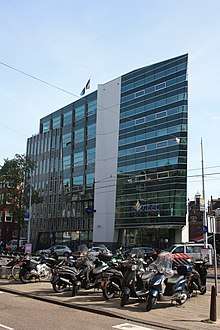
"Amsterdam" is usually understood to refer to the municipality of Amsterdam. Colloquially, some areas within the municipality, such as the town of Durgerdam, may not be considered part of Amsterdam.
Statistics Netherlands uses three other definitions of Amsterdam: metropolitan agglomeration Amsterdam (Grootstedelijke Agglomeratie Amsterdam, not to be confused with Grootstedelijk Gebied Amsterdam, a synonym of Groot Amsterdam), Greater Amsterdam (Groot Amsterdam, a COROP region) and the urban region Amsterdam (Stadsgewest Amsterdam).[8] The Amsterdam Department for Research and Statistics uses a fourth conurbation, namely the Stadsregio Amsterdam ('City Region of Amsterdam'). The city region is similar to Greater Amsterdam but includes the municipalities of Zaanstad and Wormerland. It excludes Graft-De Rijp.
The smallest of these areas is the municipality of Amsterdam with a population of 802,938 in 2013.[8] The conurbation had a population of 1,096,042 in 2013.[8] It includes the municipalities of Zaanstad, Wormerland, Oostzaan, Diemen and Amstelveen only, as well as the municipality of Amsterdam.[8] Greater Amsterdam includes 15 municipalities,[8] and had a population of 1,293,208 in 2013.[8] Though much larger in area, the population of this area is only slightly larger, because the definition excludes the relatively populous municipality of Zaanstad. The largest area by population, the Amsterdam Metropolitan Area (Dutch: Metropoolregio Amsterdam), has a population of 2,33 million.[208] It includes for instance Zaanstad, Wormerland, Muiden, Abcoude, Haarlem, Almere and Lelystad but excludes Graft-De Rijp. Amsterdam is part of the conglomerate metropolitan area Randstad, with a total population of 6,659,300 inhabitants.[209]
Of these various metropolitan area configurations, only the Stadsregio Amsterdam (City Region of Amsterdam) has a formal governmental status. Its responsibities include regional spatial planning and the metropolitan public transport concessions.[210]
National capital
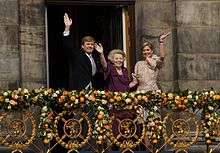
Under the Dutch Constitution, Amsterdam is the capital of the Netherlands. Since the 1983 constitutional revision, the constitution mentions "Amsterdam" and "capital" in chapter 2, article 32: The king's confirmation by oath and his coronation take place in "the capital Amsterdam" ("de hoofdstad Amsterdam").[211] Previous versions of the constitution only mentioned "the city of Amsterdam" ("de stad Amsterdam").[212] For a royal investiture, therefore, the States General of the Netherlands (the Dutch Parliament) meets for a ceremonial joint session in Amsterdam. The ceremony traditionally takes place at the Nieuwe Kerk on Dam Square, immediately after the former monarch has signed the act of abdication at the nearby Royal Palace of Amsterdam. Normally, however, the Parliament sits in The Hague, the city which has historically been the seat of the Dutch government, the Dutch monarchy, and the Dutch supreme court. Foreign embassies are also located in The Hague.
Symbols
The coat of arms of Amsterdam is composed of several historical elements. First and centre are three St Andrew's crosses, aligned in a vertical band on the city's shield (although Amsterdam's patron saint was Saint Nicholas). These St Andrew's crosses can also be found on the cityshields of neighbours Amstelveen and Ouder-Amstel. This part of the coat of arms is the basis of the flag of Amsterdam, flown by the city government, but also as civil ensign for ships registered in Amsterdam. Second is the Imperial Crown of Austria. In 1489, out of gratitude for services and loans, Maximilian I awarded Amsterdam the right to adorn its coat of arms with the king's crown. Then, in 1508, this was replaced with Maximilian's imperial crown when he was crowned Holy Roman Emperor. In the early years of the 17th century, Maximilian's crown in Amsterdam's coat of arms was again replaced, this time with the crown of Emperor Rudolph II, a crown that became the Imperial Crown of Austria. The lions date from the late 16th century, when city and province became part of the Republic of the Seven United Netherlands. Last came the city's official motto: Heldhaftig, Vastberaden, Barmhartig ("Heroic, Determined, Merciful"), bestowed on the city in 1947 by Queen Wilhelmina, in recognition of the city's bravery during the Second World War.
Transport
Metro, tram and bus

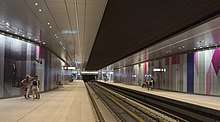
Currently, there are sixteen tram routes and five metro routes. All are operated by municipal public transport operator Gemeentelijk Vervoerbedrijf (GVB), which also runs the city bus network.
Four fare-free GVB ferries carry pedestrians and cyclists across the IJ lake to the borough of Amsterdam-Noord, and two fare-charging ferries run east and west along the harbour. There are also privately operated water taxis, a water bus, a boat sharing operation, electric rental boats and canal cruises, that transport people along Amsterdam's waterways.
Regional buses, and some suburban buses, are operated by Connexxion and EBS. International coach services are provided by Eurolines from Amsterdam Amstel railway station, IDBUS from Amsterdam Sloterdijk railway station, and Megabus from the Zuiderzeeweg in the east of the city.
In order to facilitate easier transport to the center of Amsterdam, the city has various P+R Locations where people can park their car at an affordable price and transfer to one of the numerous public transport lines.[213]
Car
Amsterdam was intended in 1932 to be the hub, a kind of Kilometre Zero, of the highway system of the Netherlands,[214] with freeways numbered One to Eight planned to originate from the city.[214] The outbreak of the Second World War and shifting priorities led to the current situation, where only roads A1, A2, and A4 originate from Amsterdam according to the original plan. The A3 to Rotterdam was cancelled in 1970 in order to conserve the Groene Hart. Road A8, leading north to Zaandam and the A10 Ringroad were opened between 1968 and 1974.[215] Besides the A1, A2, A4 and A8, several freeways, such as the A7 and A6, carry traffic mainly bound for Amsterdam.
The A10 ringroad surrounding the city connects Amsterdam with the Dutch national network of freeways. Interchanges on the A10 allow cars to enter the city by transferring to one of the 18 city roads, numbered S101 through to S118. These city roads are regional roads without grade separation, and sometimes without a central reservation. Most are accessible by cyclists. The S100 Centrumring is a smaller ringroad circumnavigating the city's centre.
In the city centre, driving a car is discouraged. Parking fees are expensive, and many streets are closed to cars or are one-way.[216] The local government sponsors carsharing and carpooling initiatives such as Autodelen and Meerijden.nu.[217] The local government has also started removing parking spaces in the city, with the goal of removing 10,000 spaces (roughly 1,500 per year) by 2025[218]
National rail
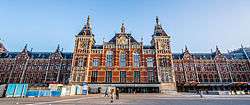
Amsterdam is served by ten stations of the Nederlandse Spoorwegen (Dutch Railways).[219] Five are intercity stops: Sloterdijk, Zuid, Amstel, Bijlmer ArenA and Amsterdam Centraal. The stations for local services are: Lelylaan, RAI, Holendrecht, Muiderpoort and Science Park. Amsterdam Centraal is also an international railway station. From the station there are regular services to destinations such as Austria, Belarus, Belgium, Czechia, Denmark, France, Germany, Hungary, Poland, Russia, Switzerland and the United Kingdom. Among these trains are international trains of the Nederlandse Spoorwegen (Amsterdam-Berlin), the Eurostar (Amsterdam-Brussels-London), Thalys (Amsterdam-Brussels-Paris/Lille), and Intercity-Express (Amsterdam–Cologne–Frankfurt).[220][221][222]
Airport
.jpg)
Amsterdam Airport Schiphol is less than 20 minutes by train from Amsterdam Centraal station and is served by domestic and international intercity trains, such as Thalys, Eurostar and Intercity Brussel. Schiphol is the largest airport in the Netherlands, the third largest in Europe, and the 14th-largest in the world in terms of passengers. It handles over 68 million passengers per year and is the home base of four airlines, KLM, Transavia, Martinair and Arkefly.[223] As of 2014, Schiphol was the fifth busiest airport in the world measured by international passenger numbers.[224] This airport is 4 meters below sea level.[225]. Although Schiphol is internationally known as Amsterdam Schiphol Airport it actually lies in the neighbouring municipality of Haarlemmermeer, southwest of the city.
Cycling
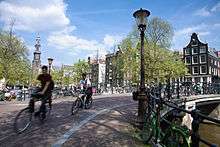
Amsterdam is one of the most bicycle-friendly large cities in the world and is a centre of bicycle culture with good facilities for cyclists such as bike paths and bike racks, and several guarded bike storage garages (fietsenstalling) which can be used.
According to the most recent figures published by Central Bureau of Statistics (CBS), in 2015 the 442.693 households (850.000 residents) in Amsterdam together owned 847.000 bicycles – 1.91 bicycle per household. Previously, wildly different figures were arrived at using a Wisdom of the crowd approach.[226] Theft is widespread—in 2011, about 83,000 bicycles were stolen in Amsterdam.[227] Bicycles are used by all socio-economic groups because of their convenience, Amsterdam's small size, the 400 kilometres (249 miles) of bike paths,[228] the flat terrain, and the inconvenience of driving an automobile.[229]
Education
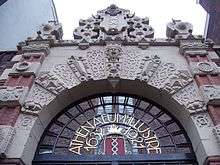
Amsterdam has two universities: the University of Amsterdam (Universiteit van Amsterdam, UvA), and the Vrije Universiteit Amsterdam (VU). Other institutions for higher education include an art school – Gerrit Rietveld Academie, a university of applied sciences – the Hogeschool van Amsterdam, and the Amsterdamse Hogeschool voor de Kunsten. Amsterdam's International Institute of Social History is one of the world's largest documentary and research institutions concerning social history, and especially the history of the labour movement. Amsterdam's Hortus Botanicus, founded in the early 17th century, is one of the oldest botanical gardens in the world,[230] with many old and rare specimens, among them the coffee plant that served as the parent for the entire coffee culture in Central and South America.[231]
There are over 200 primary schools in Amsterdam.[232] Some of these primary schools base their teachings on particular pedagogic theories like the various Montessori schools. The biggest Montessori high school in Amsterdam is the Montessori Lyceum Amsterdam. Many schools, however, are based on religion. This used to be primarily Roman Catholicism and various Protestant denominations, but with the influx of Muslim immigrants there has been a rise in the number of Islamic schools. Jewish schools can be found in the southern suburbs of Amsterdam.
Amsterdam is noted for having five independent grammar schools (Dutch: gymnasia), the Vossius Gymnasium, Barlaeus Gymnasium, St. Ignatius Gymnasium, Het 4e Gymnasium and the Cygnus Gymnasium where a classical curriculum including Latin and classical Greek is taught. Though believed until recently by many to be an anachronistic and elitist concept that would soon die out, the gymnasia have recently experienced a revival, leading to the formation of a fourth and fifth grammar school in which the three aforementioned schools participate. Most secondary schools in Amsterdam offer a variety of different levels of education in the same school. The city also has various colleges ranging from art and design to politics and economics which are mostly also available for students coming from other countries.
Schools for foreign nationals in Amsterdam include the Amsterdam International Community School, British School of Amsterdam, Albert Einstein International School Amsterdam, Lycée Vincent van Gogh La Haye-Amsterdam primary campus (French school), International School of Amsterdam, and the Japanese School of Amsterdam.
Notable people
Media
Amsterdam is a prominent centre for national and international media. Some locally based newspapers include Het Parool, a national daily paper; De Telegraaf, the largest Dutch daily newspaper; the daily newspapers Trouw, de Volkskrant and NRC Handelsblad; De Groene Amsterdammer, a weekly newspaper; the free newspapers Metro and The Holland Times (printed in English).
Amsterdam is home to the second-largest Dutch commercial TV group SBS Broadcasting Group, consisting of TV-stations SBS 6, Net 5 and Veronica. However, Amsterdam is not considered 'the media city of the Netherlands'. The town of Hilversum, 30 kilometres (19 miles) south-east of Amsterdam, has been crowned with this unofficial title. Hilversum is the principal centre for radio and television broadcasting in the Netherlands. Radio Netherlands, heard worldwide via shortwave radio since the 1920s, is also based there. Hilversum is home to an extensive complex of audio and television studios belonging to the national broadcast production company NOS, as well as to the studios and offices of all the Dutch public broadcasting organisations and many commercial TV production companies.
In 2012, the music video of Far East Movement, 'Live My Life', was filmed in various parts of Amsterdam.
Also, several movies were filmed in Amsterdam, such as James Bond's Diamonds Are Forever, Ocean's Twelve, Girl with a Pearl Earring and The Hitman's Bodyguard. Amsterdam is also featured in John Green's book The Fault in Our Stars, which has been made into a film as well that partly takes place in Amsterdam.
Housing
The housing market is heavily regulated. The increased influx of migrants, especially since the Syrian Civil War (2011-present), has been burdensome, economically and culturally, but the government deals with citizen and migrant cases for housing equally. According to the Netherlands' Organisation for Economic Co-operation and Developmen, "60% of housing stock is controlled by housing corporations. No different treatment for migrant groups".[233]
From the late 1960s onwards many buildings in Amsterdam have been squatted both for housing and for using as social centres.[234] A number of these squats have legalised and become well known, such as OCCII, OT301, Paradiso and Vrankrijk.
Notes and references
Citations
- "Portfolios: Mayor & Alderpersons". Gemeente Amsterdam. Archived from the original on 28 February 2014. Retrieved 18 February 2014.
- "Kerncijfers wijken en buurten" [Key figures for neighbourhoods]. CBS Statline (in Dutch). CBS. 2 July 2013. Retrieved 12 March 2014.
- Anita Bouman–Eijs; Thijmen van Bree; Wouter Jonkhoff; Olaf Koops; Walter Manshanden; Elmer Rietveld (17 December 2012). De Top 20 van Europese grootstedelijke regio's 1995–2011; Randstad Holland in internationaal perspectief [Top 20 of European metropolitan regions 1995–2011; Randstad Holland compared internationally] (PDF) (Technical report) (in Dutch). Delft: TNO. Archived from the original (PDF) on 3 March 2014. Retrieved 25 July 2013.
- "Postcodetool for 1012JS (Dam Square)". Actueel Hoogtebestand Nederland (in Dutch). Het Waterschapshuis. Archived from the original on 21 September 2013. Retrieved 18 February 2014.
- "Bevolking op 1 januari en gemiddeld; geslacht, leeftijd en regio". CBS StatLine (in Dutch). Retrieved 1 March 2019.
- "Bevolkingsontwikkeling; regio per maand" [Population growth; regions per month]. CBS Statline (in Dutch). CBS. 1 January 2019. Retrieved 1 January 2019.
- "Bevolkingsontwikkeling; regio per maand" [Population growth; regions per month]. CBS Statline (in Dutch). CBS. 26 June 2014. Retrieved 24 July 2014.
- "CBS Amsterdam Bevolkingsontwikkeling; regio per maand".
- "Economische Verkenningen Metropool Regio Amsterdam" (PDF).
- Wells, John C. (2008), Longman Pronunciation Dictionary (3rd ed.), Longman, ISBN 9781405881180
- Roach, Peter (2011), Cambridge English Pronouncing Dictionary (18th ed.), Cambridge: Cambridge University Press, ISBN 9780521152532
- https://opendata.cbs.nl/statline/#/CBS/nl/dataset/37230ned/table?ts=1578685738191
- "Randstad2040; Facts & Figures (p.26)" (in Dutch). VROM. Archived from the original on 12 January 2013.
- "Ranstad Monitor 2017" (PDF). Ragio Ranstad.
- Encyclopædia Britannica Eleventh Edition, Vol 1, pp. 896–898.
- Cambridge.org, Capitals of Capital -A History of International Financial Centres – 1780–2005, Youssef Cassis, ISBN 978-0-521-84535-9
- "Amsterdam verwelkomde in 2014 ruim 5 miljoen buitenlandse toeristen – Amsterdam – PAROOL".
- After Athens in 1888 and Florence in 1986, Amsterdam was in 1986 chosen as the European Capital of Culture, confirming its eminent position in Europe and the Netherlands. See EC.europa.eu for an overview of the European cities and capitals of culture over the years. Archived 14 December 2008 at the Wayback Machine
- Forbes.com, Forbes Global 2000 Largest Companies – Dutch rankings.
- "The Next Global Tech Hotspot? Amsterdam Stakes Its Claim".
- "Best cities ranking and report" (PDF).
- "Best cities in the world (Mercer)". City Mayors. 26 May 2010. Archived from the original on 1 November 2010. Retrieved 10 October 2010.
- "Tech Cities in Motion – 2019". Savills. 4 February 2019.
- "2thinknow Innovation Cities Global 256 Index – worldwide innovation city rankings". Innovation-cities.com. 30 July 2009. Archived from the original on 11 September 2010. Retrieved 10 October 2010.
- "Port Statistics 2015" (PDF) (Press release). Rotterdam Port Authority. May 2016. p. 6. Archived (PDF) from the original on 9 February 2017. Retrieved 9 February 2017.
- "Amsterdam world's most multicultural city". 26 February 2008.
- Berns & Daan 1993, p. 91.
- Mak 1994, p. 19.
- "The toll privilege of 1275 in the Amsterdam City Archives". Stadsarchief.amsterdam.nl. Archived from the original on 6 January 2016. Retrieved 10 October 2010.
- Mak 1994, pp. 18–20.
- "Amsterdam 200 jaar ouder dan aangenomen" (in Dutch). Nu.nl. 22 October 2008. Archived from the original on 25 October 2008. Retrieved 22 October 2008.
- "De geschiedenis van Amsterdam" (in Dutch). Municipality of Amsterdam. Archived from the original on 18 May 2008. Retrieved 21 May 2008.
- "Mirakel van Amsterdam" (in Dutch). Archived from the original on 8 August 2009. Retrieved 21 May 2008.
- "Eighty Years' War" (in Dutch). Leiden University. Archived from the original on 12 May 2008. Retrieved 21 May 2008.
- Case in point: After his trial and sentencing in Rome in 1633, Galileo chose Lodewijk Elzevir in Amsterdam to publish one of his finest works, Two New Sciences. See Wade Rowland (2003), Galileo's Mistake, A new look at the epic confrontation between Galileo and the Church, New York: Arcade Publishing, ISBN 1-55970-684-8, p. 260.
- Braudel, Fernand (1983). Civilization and capitalism 15th–18th century: The wheels of commerce. New York: Harper & Row. ISBN 978-0060150914.
- E. Haverkamp-Bergmann, Rembrandt; The Night Watch (New Jersey: Princeton University Press, 1982), p. 57
- Amsterdam in the 17th century Archived 26 August 2009 at the Wayback Machine, The University of North Carolina at Pembroke
- "Amsterdam through the ages -A medieval village becomes a global city". Archived from the original on 1 May 2008. Retrieved 21 May 2008.
- "Aardappeloproer – Legermuseum" (PDF) (in Dutch). Archived from the original (PDF) on 28 May 2008. Retrieved 21 May 2008.
- "Amsterdam city archives". Archived from the original on 6 October 2014. Retrieved 4 October 2014.
- http://www.centraledorpenraad.nl/landelijk-noord/historie Archived 11 July 2014 at the Wayback Machine from website for the centrale dorpen raad (villages central council)
- "Deportation to camps". Hollandsche Schouwburg. Retrieved 21 May 2008.
- "Kou en strijd in een barre winter" (in Dutch). NOS. Archived from the original on 23 January 2008. Retrieved 21 May 2008.
- "Stadsdeel Slotervaart – Geschiedenis" (in Dutch). Municipality Amsterdam. Archived from the original on 3 May 2008. Retrieved 22 May 2008.
- "Stadsherstel Missie/Historie" (in Dutch). Retrieved 22 May 2008.
- "Typisch Metrostad" (in Dutch). Municipality Amsterdam. Archived from the original on 10 June 2008. Retrieved 22 May 2008.
- "Grachtengordel Amsterdam Werelderfgoed" (in Dutch). Gemeente Amsterdam. Retrieved 5 August 2015.
- "Seventeenth-century canal ring area of Amsterdam inside the Singelgracht – UNESCO World Heritage Centre". Whc.unesco.org. Retrieved 31 January 2012.
- "Amsterdamhotspots.nl". Archived from the original on 4 April 2007. Retrieved 19 April 2007.
- "World Executive City Guides – Amsterdam". Retrieved 19 April 2007.
- "Amsterdam als koelkastmagneetje" [Amsterdam as a fridge magnet]. De Groene Amsterdammer. 27 July 2016.
- "Winkelomzet in Amsterdamse binnenstad explodeerde in 2015". Het Parool. 28 January 2016. Archived from the original on 3 February 2016. Retrieved 22 June 2016.
- "Geschiedenis van een debacle". Het Parool. 17 April 2008.
- "Werk aan Amsterdamse Noord-Zuidlijn hervat". NOS.nl. Retrieved 22 June 2016.
- "Bouw Noord/Zuidlijn is voltooid: metrostations en lijn klaar om proef te draaien". at5.nl. Retrieved 16 September 2018.
- "Plan Openbare Ruimte Frederik Hendrikbuurt" (PDF) (in Dutch). Retrieved 26 September 2016.
- "Structural Vision Amsterdam 2040" (in Dutch). Retrieved 26 September 2016.
- "Actueel Hoogtebestand Nederland" (in Dutch). Retrieved 18 May 2008.
- "Kerncijfers Amsterdam 2007" (PDF) (in Dutch). Archived from the original (PDF) on 28 May 2008. Retrieved 18 May 2008.
- "Openbare ruimte en groen: Inleiding" (in Dutch). Archived from the original on 24 June 2008. Retrieved 18 May 2008.
- "Adventure". 16 June 2008. Archived from the original on 9 July 2014. Retrieved 17 June 2014.
- "Amsterdam, Netherlands Köppen Climate Classification (Weatherbase)". Weatherbase. Retrieved 2 July 2019.
- "06240: Amsterdam Airport Schiphol (Netherlands)". OGIMET. Retrieved 25 July 2019.
- "Extreme temperatures around the world". Herrera, Maximiliano. Retrieved 2 March 2012.
- "Stationsdata station Schiphol 1981–2010" (PDF). Royal Netherlands Meteorological Institute. Retrieved 10 September 2013.
- "Klimaattabel Schiphol, langjarige gemiddelden, tijdvak 1981–2010" (PDF) (in Dutch). Royal Netherlands Meteorological Institute. Retrieved 9 September 2013.
- "Klimaattabel Schiphol, langjarige extremen, tijdvak 1971–2000" (PDF) (in Dutch). Royal Netherlands Meteorological Institute. Retrieved 9 September 2013.
- d.o.o, Yu Media Group. "Amsterdam, Netherlands – Detailed climate information and monthly weather forecast". Weather Atlas. Retrieved 2 July 2019.
- "History of Amsterdam, The Early History". Bureau Monumenten & Archeologie (Office of Monuments and Archeology). Archived from the original on 2 April 2007. Retrieved 19 April 2007.
- Bairoch, Paul (18 June 1991). Cities and Economic Development: From the Dawn of History to the Present. University of Chicago Press. p. 140. ISBN 9780226034669.
- Paping, Richard (September 2014). "General Dutch population development 1400–1850" (PDF). University of Groningen. p. 12–13.
- Bogucka, M. (1983), Wieringa, W. J. (ed.), The Interactions of Amsterdam and Antwerp with the Baltic region, 1400–1800. The Baltic and Amsterdam in the First Half of the 17th Century, Werken, Springer Netherlands, pp. 51–57, doi:10.1007/978-94-017-5952-6_7, ISBN 9789401759526
- Henk van Nierop, "Amsterdam", Oxford Bibliographies Online. 28 March 2018. DOI: 10.1093/OBO/9780195399301-0106; and Jessica Dijkman, Shaping Medieval Markets: The Organisation of Commodity Markets in Holland, c.1200 - c. 1450 (Leiden: Brill, 2011). ISBN 9789004201484
- Prak, Maarten (22 September 2005). The Dutch Republic in the Seventeenth Century: The Golden Age. Cambridge University Press. p. 252. ISBN 9781316342480.
- Liedtke, Walter A.; Vermeer, Johannes; Plomp, Michiel; Rüger, Axel (2001). Vermeer and the Delft School. Metropolitan Museum of Art. p. 197. ISBN 9780870999734.
- Schmidt, Freek (28 July 2017). Passion and Control: Dutch Architectural Culture of the Eighteenth Century. Routledge. ISBN 9781134797042.
- Hood, Clifton (8 November 2016). In Pursuit of Privilege: A History of New York City's Upper Class and the Making of a Metropolis. Columbia University Press. p. 14. ISBN 9780231542951.
- Frijhoff & Prak 2005, p. 9.
- Engeli, Christian; Matzerath, Horst (1989). Modern urban history research in Europe, USA, and Japan: a handbook. Berg. ISBN 9780854960408.
- Van Leeuwen & Oeppen 1993, p. 87
- Floud, Roderick; Humphries, Jane; Johnson, Paul (9 October 2014). The Cambridge Economic History of Modern Britain: Volume 1, Industrialisation, 1700–1870. Cambridge University Press. pp. 15–16. ISBN 9781316061152.
- Mulder, Eduardo F. J. De; Pater, Ben C. De; Fortuijn, Joos C. Droogleever (28 July 2018). The Netherlands and the Dutch: A Physical and Human Geography. Springer. p. 152. ISBN 9783319750736.
- Tzaninis, Yannis; Boterman, Willem (2 January 2018). "Beyond the urban–suburban dichotomy". City. 22 (1): 43–62. doi:10.1080/13604813.2018.1432143. ISSN 1360-4813.
- van der Wouden, Ries (2016). "The Spatial Transformation of the Netherlands 1988—2015". The Netherlands Environmental Assessment Agency (PBL). 6. Archived from the original on 23 February 2019. Retrieved 23 February 2019.
- Musterd, Sako; Ostendorf, Wim (3 April 2008). "Integrated urban renewal in The Netherlands: a critical appraisal" (PDF). Urban Research & Practice. 1 (1): 78–92. doi:10.1080/17535060701795389. ISSN 1753-5069.
- van Gent, W.P.C. (2008). "The context of neighbourhood regeneration in Western Europe. A comparative study of nine neighbourhoods undergoing physical and social economic regeneration" (PDF). University of Amsterdam. p. 148.
- "Gentrification in Amsterdam: Assessing the Importance of Context". Population Space and Place. Retrieved 23 February 2019.
- "Amsterdam is expanding, mainly due to immigration". Statistics Netherlands. Retrieved 23 February 2019.
- "Amsterdam's population poised to beat 60-year-old record". DutchNews.nl. 21 February 2019. Retrieved 23 February 2019.
- "CBS StatLine – Bevolking; leeftijd, herkomstgroepering, geslacht en regio, 1 januari".
- "The Netherlands". Holocaust Encyclopedia. Retrieved 24 January 2019.
- "Half of young big-city dwellers have non-western background". Cbs.nl. Retrieved 10 October 2010.
- "Bevolking naar herkomstgroepering, 1 January 2001–2006" (in Dutch). Dienst Onderzoek en Statistiek (Research and Statistics Service). Archived from the original on 7 August 2009. Retrieved 19 April 2007.
- "Most foreign babies born in big cities". Cbs.nl. 26 April 2004. Retrieved 10 October 2010.
- Terpstra, Jendra (28 March 2017). "Wit is de 'nieuwe minderheid' in grote steden". Trouw.nl (in Dutch). Retrieved 30 June 2018.
- "Statistics on a map" (in Dutch).
- "Statistics by Neighborhood" (in Dutch).
- "Religie Amsterdam" (PDF) (in Dutch). Archived from the original (PDF) on 28 May 2008. Retrieved 22 May 2008.
- "Bureau of Onderzoek en Statistiek: 'Geloven in Amsterdam'" (PDF). Retrieved 25 April 2012.
- "Kerkelijke gezindte en kerkbezoek naar gemeenten 2010–2015". Centraal Bureau voor de Statistiek.
- World and Its Peoples. Marshall Cavendish. 2010. p. 558. ISBN 9780761478904.
- Esser, Raingard (17 February 2012). The Politics of Memory: The Writing of Partition in the Seventeenth-Century Low Countries. BRILL. p. 34. ISBN 9789004208070.
- Let's Go Amsterdam 5th Edition. Macmillan. 27 November 2007. p. 58. ISBN 9780312374549.
- Stiefel, Barry L. (6 October 2015). Jews and the Renaissance of Synagogue Architecture, 1450–1730. Routledge. p. 67. ISBN 9781317320326.
- Israel, Jonathan (Fall 1989). "Sephardic Immigration into the Dutch Republic, 1595–1672". Studia Rosenthaliana. 23: 45–53. JSTOR 41481727.
- Warshawsky, Matthew D. (July 2018). ""All True, All Holy, All Divine": Jewish Identity in the Polemics and Letters of Isaac Orobio de Castro, a Former Portuguese New Christian in 1600s Amsterdam". Journal of Jewish Identities. 11 (2): 267–283. doi:10.1353/jji.2018.0017.
During the 1600s, Amsterdam stood out from these other locales as a center of settlement by people of Sephardic, or Iberian Jewish
- Marshall, John (30 March 2006). John Locke, Toleration and Early Enlightenment Culture. Cambridge University Press. p. 17. ISBN 9780521651141.
- Terpstra, Nicholas (23 July 2015). Religious Refugees in the Early Modern World: An Alternative History of the Reformation. Cambridge University Press. ISBN 9781316351901.
- Stiefel, Barry (1 January 2011). "The Architectural Origins of the Great Early Modern Urban Synagogue". The Leo Baeck Institute Year Book. 56 (1): 105–134. doi:10.1093/leobaeck/ybr006. ISSN 0075-8744.
- Mak, Geert (30 September 2010). Amsterdam: A brief life of the city. Random House. p. 108. ISBN 9781409000853.
- "English Reformed Church Amsterdam". Archived from the original on 24 January 2005. Retrieved 22 May 2008.
- "History of Jews in Amsterdam". Jewish Virtual Library. Retrieved 23 February 2019.
- "Amsterdamse wijken" (in Dutch). Municipality Amsterdam. Archived from the original on 25 January 2008. Retrieved 22 May 2008.
- Lebovic, Matt. "In Anne Frank's childhood neighborhood, the buildings do not forget". Times of Israel. Retrieved 23 February 2019.
- Duin, Leen van (2009). The Urban Project: Architectural Intervention in Urban Areas. IOS Press. ISBN 9781586039998.
- The Jewish Week and the American Examiner. Jewish Week and the American Examiner, Incorporated. 12 January 1974.
- Lebovic, Matt. "New cultural quarter resurrects Amsterdam's Jewish past". Times of Israel. Retrieved 23 February 2019.
- Pope Pius IX (4 March 1853). de Martinis, Raffaele (ed.). "Ex qua die arcano". Iuris Pontificii de Propaganda Fide: Pars Prima, Complectens Bullas, Brevia Acta S.S. A Congregationis Institutione Ad Praesens Iuxta Temporis Seriem Disposita (in Latin). Rome: Ex Typographia Polyglotta (published 1894). 6 (1): 158–161. OCLC 3342505. Translated in "XIIIb: the apostolic letters of the most holy Lord Pius IX, by Divine Providence, pope, by which letters the episcopal hierarchy was re-established in Holland". Further papers regarding the relation of foreign states with the Court of Rome: presented to the House of Commons by command of Her Majesty, in pursuance of their address of June 14, 1853. London: Harrison and Son. 1853. pp. 61–65. OCLC 80498785.
- Maeyer, Jan de (2007). Renaissance de L'enluminure Médiévale: Manuscrits Et Enluminures Belges Du XIXe Siègle Et Leur Contexte Européen. Leuven University Press. p. 191. ISBN 9789058675910.
- Jong, Taeke M. de; Voordt, D. J. M. van der (2002). Ways to Study and Research: Urban, Architectural, and Technical Design. IOS Press. p. 118. ISBN 9789040723322.
- Kirkfleet, C. J. (April 1926). "International Eucharistic Congresses". The Catholic Historical Review. 12 (1): 59–65. JSTOR 25012268.
- Illinois Catholic Historical Review. Illinois Catholic Historical Society. 1925.
- Catholic World. Paulist Fathers. 1924. p. 845.
- Arab, Pooyan Tamimi (9 February 2017). Amplifying Islam in the European Soundscape: Religious Pluralism and Secularism in the Netherlands. Bloomsbury Publishing. p. 173. ISBN 9781474291446.
- "Diocese of Haarlem". Catholic Hierarchy. Archived from the original on 14 June 2008. Retrieved 4 June 2008.
- Swamy, Priya (17 November 2017). "Valuing flexible citizenship: producing Surinamese Hindu citizens at a primary school in The Hague". Citizenship Studies. 21 (8): 1052–1066. doi:10.1080/13621025.2017.1361905. ISSN 1362-1025.
- Avest, K. H. (Ina) Ter; Wingerden, M. (Marjoke) Rietveld-van (2 September 2017). "Half a century of Islamic education in Dutch schools". British Journal of Religious Education. 39 (3): 293–302. doi:10.1080/01416200.2015.1128391. ISSN 0141-6200.
- Kessel, Ineke van (2002). "Ghanaian churches in the Netherlands: Religion mediating a tense relationship" (PDF). Merchants, Missionaries & Migrants: 300 Years of Dutch-Ghanaian Relations. KIT Publishers. ISBN 9789988550776.
- Religion, Ethnicity and Transnational Migration between West Africa and Europe. BRILL. 15 May 2014. p. 179. ISBN 9789004271562.
- Onderzoek, Informatie en Statistiek, Gemeente Amsterdam
- Quest, issue of March 2009
- "Amsterdam in cijfers 2010". Os.amsterdam.nl. Archived from the original on 18 March 2012. Retrieved 25 April 2012.
- "Inwoneraantal Amsterdam blijft groeien – Gemeente Amsterdam". 25 November 2014. Archived from the original on 25 November 2014.
- Amsterdam, Universiteit van. "Dutch for foreigners – INTT – University of Amsterdam". Archived from the original on 2 April 2015. Retrieved 12 March 2015.
- "Amsterdamse Grachten" (in Dutch). Municipality Amsterdam. Archived from the original on 20 March 2008. Retrieved 21 May 2008.
- "SHVriendenwandeling2017web1.pdf" (PDF). stadsherstel. Retrieved 9 April 2018.
- Taverne, E. R. M. (1978). In 't land van belofte, in de nieuwe stadt: ideaal en werkelijkheid van de stadsuitleg in de Republiek, 1580–1680 (In the land of promise, in the kinky city: ideal and reality of the city lay-out in the [Dutch] Republic, 1580–1680). Maarssen: Schwartz. ISBN 978-90-6179-024-2.
- Sako Musterd (2003). Amsterdam Human Capital. Amsterdam University Press. p. 33. ISBN 978-90-5356-595-7.
- Mak, G. (1995). Een kleine geschiedenis van Amsterdam. Amsterdam/Antwerp: Uitgeverij Atlas. ISBN 978-90-450-1232-2.
- "Dempingen en Aanplempingen" (in Dutch). Walther Schoonenberg. Archived from the original on 18 May 2008. Retrieved 21 May 2008.
- "Samuel Sarphati" (in Dutch). Joods Historisch Museum Amsterdam. Retrieved 5 June 2008.
- "Uitbreidingsplan Sarphati" (in Dutch). Zorggroep Amsterdam. Retrieved 5 June 2008.
- "Samuel Sarphati" (in Dutch). JLG Real Estate. Archived from the original on 5 August 2009. Retrieved 5 June 2008.
- "Van Niftrik's plan at the Amsterdam City Archives". Stadsarchief.amsterdam.nl. Archived from the original on 24 July 2011. Retrieved 10 October 2010.
- "Amsterdam Oud-Zuid" (in Dutch). BMZ. Archived from the original on 13 January 2008. Retrieved 5 June 2008.
- "Berlage's Expansion Plan". Stadsarchief Amsterdam. Archived from the original on 12 January 2013. Retrieved 5 June 2008.
- "Plan-Berlage" (in Dutch). Bureau Monumentenzorg Amsterdam. Archived from the original on 14 May 2006. Retrieved 5 June 2008.
- "Westelijke Tuinsteden" (in Dutch). Ymere. Archived from the original on 20 February 2005. Retrieved 5 June 2008.
- "Ontwerp Westelijke Tuinsteden" (in Dutch). Archex.info. Archived from the original on 11 June 2008. Retrieved 5 June 2008.
- "Oude Kerk official website". Retrieved 10 June 2009.
- "Houten Huys" (in Dutch). Archived from the original on 26 December 2007. Retrieved 19 May 2008.
- "Amsterdamse renaissance in de stijl van Hendrick de Keyser" (in Dutch). Archived from the original on 27 November 2007. Retrieved 19 May 2008.
- "Hollands Classicisme" (in Dutch). Archived from the original on 2 February 2007. Retrieved 21 May 2008.
- "Neo-stijlen" (in Dutch). Archived from the original on 19 August 2007. Retrieved 19 May 2008.
- "Amsterdamse School" (in Dutch). Archived from the original on 27 October 2007. Retrieved 21 May 2008.
- Amsterdamse Bos – English site Archived 19 May 2010 at the Wayback Machine. City of Amsterdam. Retrieved on 27 November 2008.
- "Amsterdam – Economische Zaken" (in Dutch). Archived from the original on 8 June 2008. Retrieved 22 May 2008.
- "European Cities Monitor 2007" (in Dutch). I Amsterdam. Archived from the original on 8 January 2008. Retrieved 11 June 2008.
- "Zuidas" (in Dutch). Archived from the original on 24 December 2007. Retrieved 22 May 2008.
- "Rembrandt Tower". Retrieved 22 May 2008.
- "Philips" (in Dutch). Archived from the original on 27 May 2008. Retrieved 22 May 2008.
- "Over Brainport". brainport.nl. Retrieved 19 February 2014.
- "Key Figures Amsterdam 2009: Tourism". City of Amsterdam Department for Research and Statistics. 2009. Archived from the original on 1 May 2011. Retrieved 30 September 2009.
- "Dutch Hotel City Index 2019" (PDF). June 2019.
- Fedorova, T; Meijer, R (January 2007). "Toerisme in Amsterdam 2006/2007" (PDF) (in Dutch). Archived (PDF) from the original on 28 May 2008. Retrieved 22 May 2008.
- Sex and Society. Marshall Cavendish. 2010. pp. 705–. ISBN 978-0-7614-7908-6.
- "PC Hooftstraat World's Third Nicest Shopping Street". dutchamsterdam.
- Gregory, Alice (8 April 2015). "Iris van Herpen's Intelligent Design". The New York Times. ISSN 0362-4331. Retrieved 23 February 2019.
- Phillips, Sarah (7 July 2010). "Photographers Inez van Lamsweerde and Vinoodh Matadin's best shot". The Guardian. ISSN 0261-3077. Retrieved 23 February 2019.
- Stein, Robert; Pollmann, Judith (2010). Networks, Regions and Nations: Shaping Identities in the Low Countries, 1300–1650. BRILL. p. 56. ISBN 9789004180246.
- Ridder-Symoens, Hilde De; Goudriaan, Koen; Moolenbroek, J. J. Van; Tervoort, Ad (2004). Education and learning in the Netherlands, 1400–1600 [electronic resource]: essays in honour of Hilde de Ridder-Symoens. BRILL. p. 215. ISBN 9789004136441.
- "Schouwburg | theatre, Amsterdam, Netherlands". Encyclopedia Britannica. Retrieved 24 February 2019.
- Craine, Debra; Mackrell, Judith (19 August 2010). The Oxford Dictionary of Dance. OUP Oxford. p. 321. ISBN 9780199563449.
- Bloemendal, Jan; Korsten, Frans-Willem (25 November 2011). Joost Van Den Vondel (1587–1679): Dutch Playwright in the Golden Age. BRILL. p. 143. ISBN 9789004217539.
- Grout, Donald Jay; Hermine Weigel Williams (2003). A short history of opera. Columbia University Press. p. 541. ISBN 978-0-231-11958-0. Retrieved 11 January 2010.
- Eveleth, Rose. "Was Beethoven's Metronome Wrong?". Smithsonian. Retrieved 24 February 2019.
- "History of the Rijksmuseum – Organisation". Rijksmuseum. Retrieved 24 February 2019.
- "Queen Opens the Stedelijk". Stedelijk museum. Retrieved 24 February 2019.
- Cressman, Darryl (15 March 2016). Building musical culture in Nineteenth-century Amsterdam: the concertgebouw. Amsterdam University Press. p. 137. ISBN 9789048528462.
- "Contact SBS 6" (in Dutch). Archived from the original on 24 May 2008. Retrieved 19 May 2008.
- "Feestelijke opening ijsbaan Museumplein" (in Dutch). Evenementennieuws. Archived from the original on 26 December 2008. Retrieved 30 May 2008.
- "Museumplein krijgt facelift" (in Dutch). Gemeente Amsterdam. Archived from the original on 7 August 2009. Retrieved 30 May 2008.
- "Home Page". Rijksmuseum Amsterdam. Archived from the original on 3 November 2008. Retrieved 25 October 2008.
- "Rijksmuseum". Amsterdam. A view on cities. Archived from the original on 17 September 2008. Retrieved 25 October 2008.
- "Total number of visitors of the Rijksmuseum in the Netherlands in 2014 to 2017 (in millions)". Statista. Retrieved 7 August 2018.
- "Architectuur Van Gogh Museum Amsterdam" (in Dutch). Architectuur.org. Archived from the original on 16 May 2008. Retrieved 1 June 2008.
- "Van Gogh Museum – The Building". Van Gogh Museum. Archived from the original on 13 May 2013. Retrieved 7 August 2014.
- "Van Gogh Museum – Permanent Collection". Van Gogh Museum. Retrieved 7 August 2014.
- "Historic number of visitors since opening of Van Gogh Museum". Van Gogh Museum. Retrieved 5 April 2019.
- "Amsterdams lijflied: de finale". Het Parool (in Dutch). 5 October 2011. Retrieved 8 May 2013.
- "Amsterdams Lijflied: Stadsbewoners leven als oude wolven – AMSTERDAMS LIJFLIED – PAROOL". Het Parool (in Dutch). 12 October 2011. Retrieved 8 May 2013.
- "ADE vorig jaar het best bezochte festival van Nederland". Het Parool (in Dutch). 9 June 2015. Retrieved 3 May 2017.
- "Facts & Figures". Concertgebouw NV. Retrieved 24 February 2014.
- "Amsterdam kans op 'evenementenstad'" [Amsterdam has a chance to be an 'event city']. AT5 Nieuws (in Dutch). Amsterdam. 17 May 2008. Retrieved 10 May 2012.
Naast de prijs van nationale evenementenstad is Koninginnedag voorgedragen als het publieksevenement van het jaar. (In addition to the prize for national event city, Queens Day is nominated as the public event of the year.)
- "Gay Pride in Amsterdam" (in Dutch). Municipality Amsterdam. Archived from the original on 1 June 2008. Retrieved 4 June 2008.
- "Uitmarkt in Amsterdam". IAmsterdam. Archived from the original on 31 January 2008. Retrieved 4 June 2008.
- "De Meer". Stadiums. AFC Ajax. Archived from the original on 16 November 2008. Retrieved 8 November 2008.
- "Athletics" (in Dutch). Olympisch Stadion Amsterdam. SOSA. Archived from the original on 21 December 2008. Retrieved 8 November 2008.
- "Over Sporthallen Zuid: Referenties". Sporthallenzuid.amsterdam.nl. 7 September 2009. Archived from the original on 3 August 2010. Retrieved 10 October 2010.
- "FIG allocates 2023 World Gymnaestrada to Amsterdam". Around The Rings. Retrieved 20 February 2019.
- "Amsterdam City Districts". Iamsterdam.com. Archived from the original on 20 August 2014. Retrieved 12 August 2014.
- Maria Smith (15 February 2018). "Electing a mayor in the Netherlands". DutchReview.com. Retrieved 15 February 2018.
- Britt Slegers (12 June 2014). "Three-party coalition in Amsterdam". NL Times. Retrieved 13 August 2014.
- "College van burgemeester en wethouders" (in Dutch). City of Amsterdam. Retrieved 13 August 2014.
- https://nos.nl/artikel/2193622-zieke-amsterdamse-burgemeester-van-der-laan-legt-werk-neer.html/%5B%5D
- "Dienst onderzoek & statistiek Amsterdam". Archived from the original on 14 June 2013.
- "Population" (in Dutch). Themes. City of Amsterdam. October 2008. Retrieved 8 March 2009.
- "Stadsregio Amsterdam: English Information". Stadsregio Amsterdam. Retrieved 12 August 2014.
- Dutch Wikisource. "Grondwet voor het Koninkrijk der Nederlanden" [Constitution for the Kingdom of the Netherlands] (in Dutch). Chapter 2, Article 32. Retrieved 3 July 2013.
... de hoofdstad Amsterdam ...
- "Previous versions of the constitution" (in Dutch). Nl.wikisource.org. Retrieved 10 October 2010.
- "Parkeren + Reizen (P+R) Amsterdam – I amsterdam". www.iamsterdam.com.
- "Autosnelweg.nl – Geschiedenis Autosnelwegen in Nederland" (in Dutch). Autosnelweg.nl. Archived from the original on 10 March 2007. Retrieved 19 April 2007.
- "Autosnelweg.nl – Geschiedenis Autosnelwegen in Nederland" (in Dutch). Autosnelweg.nl. Archived from the original on 16 March 2007. Retrieved 19 April 2007.
- "Amsterdam Fietst" (in Dutch). Archived from the original on 6 August 2007. Retrieved 19 April 2007.
- "Amsterdam.nl – Auto" (in Dutch). Archived from the original on 5 April 2007. Retrieved 19 April 2007.
- Koops, Ruben (28 March 2019). "Ruim 10.000 parkeerplaatsen verdwijnen voor 2025". Het Parool (in Dutch). Retrieved 10 April 2020.
- "Stationsweb-Noord Holland" (in Dutch). Archived from the original on 29 April 2007. Retrieved 19 April 2007.
- "Train to Amsterdam – London to Amsterdam – Eurostar". www.eurostar.com.
- "Discover our train destinations". Nederlandse Spoorwegen. Retrieved 16 March 2019.
- UK, DVV Media. "Eurostar undertakes detailed planning for London – Amsterdam service".
- Maslen, Richard (21 July 2014). "easyJet to open Amsterdam Base in Spring 2015". UBM (UK) Ltd.
- "International passenger Rankings". ACI Airports Council International. Retrieved 3 June 2014.
- awesomeamsterdam (16 October 2015). "10 FUN FACTS ABOUT AMSTERDAM". AWESOME AMSTERDAM. Retrieved 16 January 2019.
- "Amsterdam, City of Bikes". DutchAmsterdam.nl. Archived from the original on 29 August 2019. Retrieved 11 November 2019.
- Research and Statistics Division. "Core Numbers in Graphics: Fewer Bicycle Thefts". Safety and Nuissance (in Dutch). City of Amsterdam. Archived from the original on 22 August 2008. Retrieved 4 October 2008.
- "Cycling in Amsterdam". amsterdamtips.com. Archived from the original on 17 September 2010. Retrieved 11 August 2010.
- Tagliabue, John (20 June 2013). "The Dutch Prize Their Pedal Power, but a Sea of Bikes Swamps Their Capital". The New York Times.
- "Hortus Botanicus official website". 2009 de Hortus. Archived from the original on 31 August 2009. Retrieved 10 June 2009.
- "Higher Education in Amsterdam". Amsterdam.info. Archived from the original on 4 July 2008. Retrieved 4 June 2008.
- (in Dutch) Stedelijk Toelatingsbeleid, Municipality of Amsterdam, 2015. Retrieved on 20 July 2015.
- Organisation for Economic Co-operation and Development, Working Together for Local Integration of Migrants and Refugees in Amsterdam (Amsterdam: OECD Press, 2018), 74ff. ISBN 9789264299726
- Owens, Lynn (2009). Cracking the Movement: Narrating the Decline of the Amsterdam Squatters' Movement. Pennsylvania: Pennsylvania State University. ISBN 9780271034638.
Literature
- Berns, Jan; Daan, Jo (1993). Hij zeit wat: de Amsterdamse volkstaal. The Hague: BZZTôH. ISBN 978-9062917563.CS1 maint: ref=harv (link)
- Frijhoff, Willem; Prak, Maarten (2005), Geschiedenis van Amsterdam. Zelfbewuste stadsstaat 1650–1813, Amsterdam: SUN, ISBN 978-9058751386CS1 maint: ref=harv (link)
- Mak, Geert (1994), Een kleine geschiedenis van Amsterdam, Amsterdam & Antwerp: Atlas, ISBN 978-9045019536CS1 maint: ref=harv (link)
- Charles Caspers & Peter Jan Margry (2017), Het Mirakel van Amsterdam. Biografie van een betwiste devotie (Amsterdam, Prometheus).
- Nusteling, Hubert (1985), Welvaart en werkgelegenheid in Amsterdam 1540–1860. Een relaas over demografie, economie en sociale politiek van een wereldstad, Amsterdam: De Bataafsche Leeuw, ISBN 978-9067070829CS1 maint: ref=harv (link)
- Ramaer, J.C. (1921), "Middelpunten der bewoning in Nederland, voorheen en thans", TAG 2e Serie, 38CS1 maint: ref=harv (link)
- Van Dillen, J.G. (1929), Bronnen tot de geschiedenis van het bedrijfsleven en het gildewezen van Amsterdam, The HagueCS1 maint: ref=harv (link)
- Van Leeuwen, M.; Oeppen, J.E. (1993), "Reconstructing the Demographic Regime of Amsterdam 1681–1920", Economic and Social History in the Netherlands, 5: 61–102, hdl:10622/09251669-1993-001CS1 maint: ref=harv (link)
Further reading
External links
- Amsterdam.nl – Official government site (in Dutch)
- I amsterdam – Portal for international visitors
- Tourist information about Amsterdam – Website of the Netherlands Board of Tourism and Conventions
| Preceded by Herning, Denmark (1987) |
World Gymnaestrada host city 1991 |
Succeeded by Berlin, Germany (1995) |
| Preceded by Dornbirn, Austria (2019) |
World Gymnaestrada host city 2023 |
Succeeded by TBA |

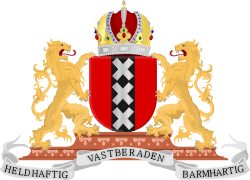

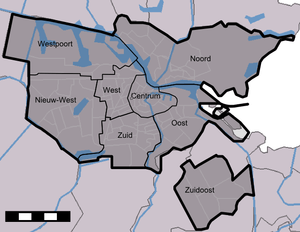


_pictogram.svg.png)
